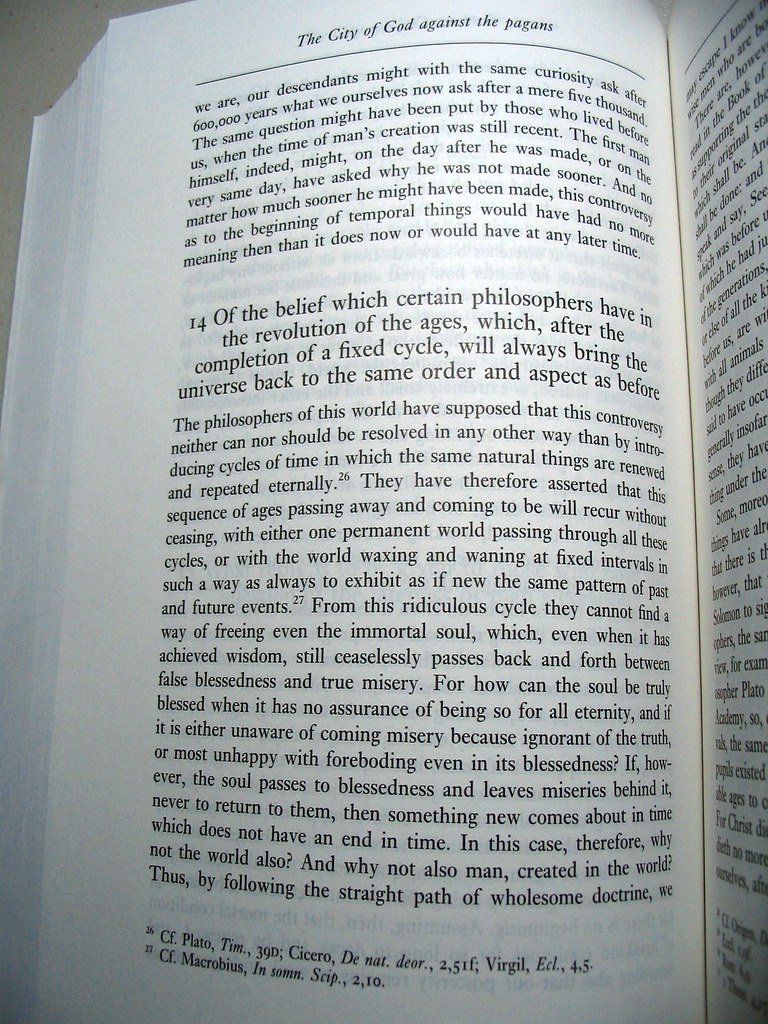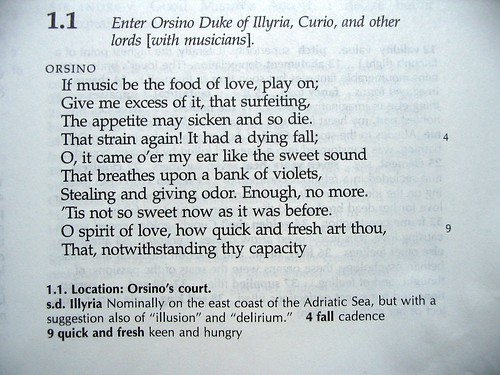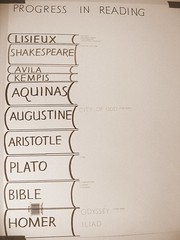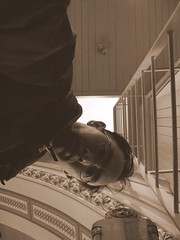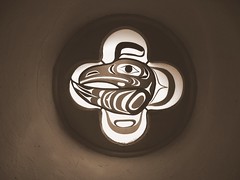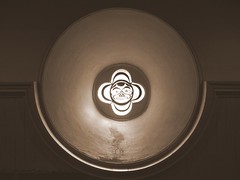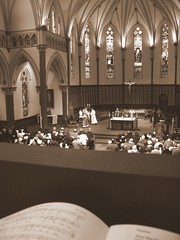Saturday, March 28, 2009
There's something about the design of this book that says "authoritative", "scholarly". The font is pleasing to the eye; it's not Times New Roman – anyone know what it is? There's something about the layout, the font, the stylistic restraint that lets you know that you are looking at a definitive, significant work.
Augustine. "The City of God against the pagans". Translated by R. W. Dyson. Cambridge University Press, 2007.
Here's another example of good book design: the Works of Shakespeare, edited by David Bevington:
One smart thing here is that line numbers are given only for lines with footnotes.
Another nice thing is that names are given in full ("Orsino") – never abbreviated.
Has a book ever struck you as exhibiting particularly good design? Post some pics!
Love the sepia effect
If you're a not-so-great photographer like me, with a not-so-great camera, I advise you to use the sepia effect. It will make your photos look ten times better.
Picasa is a good free Windows software program that lets you add this effect to your photos (and remove it later if you wish).
Tuesday, March 24, 2009
My Favorite Paintings
I've created a booklet of some of my favorite works of art (10MB PDF) – 21 works of art, spanning 500 years. I tried to make the paintings as large as possible on letter-sized paper. It looks fairly good when printed on a black-and-white laser printer. Also available as a Flickr Set.
* * *
Check out Hieronymus Bosch's painting below. Rather contemporary looking, wouldn't you think? This colorful and imaginative painting is over 500 years old.

Christ Carrying the Cross, Bosch (1490), oil on panel
www.ibiblio.org/wm/paint/auth/bosch/carrying/carrying.jpg
Below is Fra Angelico's Transfiguration. Check out the man in the lower-left corner. He's saying, "I must be going crazy – get me out of here."
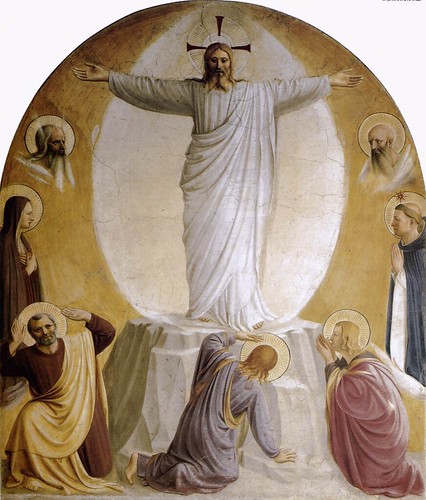
Transfiguration, Fra Angelico (1439-1443), fresco
www.wga.hu/art/a/angelico/09/cells/06_trans.jpg
Here's another colorful painting: Dürer's Christ Among the Doctors. Each of the faces is most interesting.
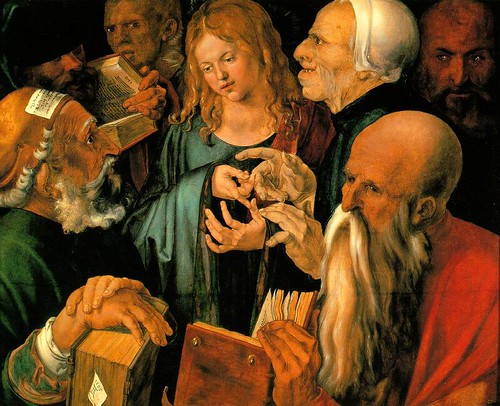
Christ Among the Doctors, Dürer (1506), oil on panel
www.dl.ket.org/webmuseum/wm/paint/auth/durer/doctors.jpg
Michelangelo's Pieta is haunting and beautiful. Jesus' mother is portrayed as a young girl, which adds an interesting effect. This looks best at larger size.
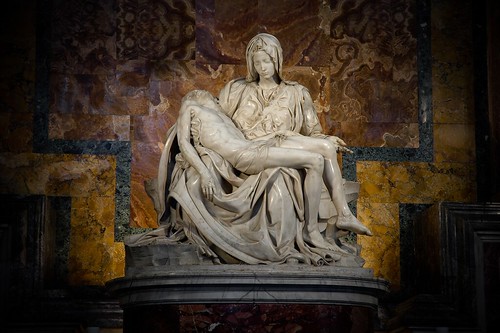
Pieta, Michelangelo (1499)
Photo by Ioja, www.flickr.com/photos/ioja/591752444/
* * *
Here is the complete list of works I selected:
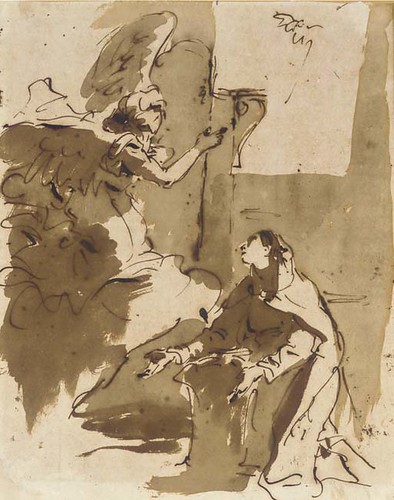
The Annunciation, Tiepolo (1696-1749), pen and brown ink, brown wash
www.christies.com/LotFinder/LargeImage.aspx?image=/lotfin...
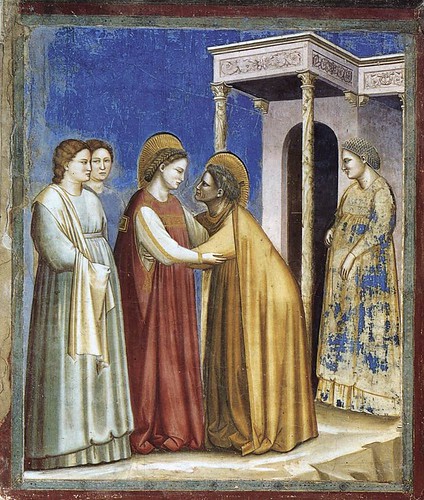
The Visit of Mary to Elisabeth, Giotto (1266-1337), fresco
www.wga.hu/art/g/giotto/padova/2virgin/mary10.jpg

The Nativity, Giotto (1304-06), fresco
www.wga.hu/art/g/giotto/padova/3christ/scenes_1/chris01.jpg

Adoration of the Shepherds, Ghirlandaio (1485), wood
i165.photobucket.com/albums/u59/teamrcia/shepher.jpg
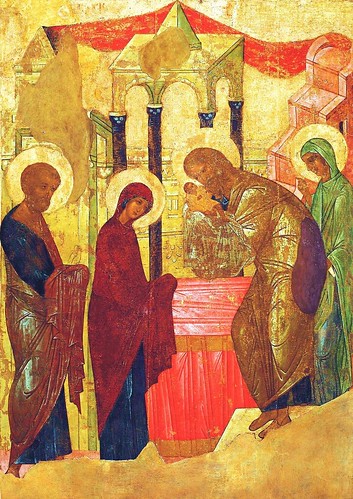
Icon of the Presentation of the Lord in the Temple, Andrei Rublev, 1405, tempera on wood
02varvara.files.wordpress.com/2008/02/entrnce-of-our-lord...

Christ Among the Doctors, Dürer (1506), oil on panel
www.dl.ket.org/webmuseum/wm/paint/auth/durer/doctors.jpg

The Baptism of Jesus Christ, El Greco (1608), oil on canvas
www.wga.hu/art/g/greco_el/12/1208grec.jpg

The Marriage at Cana, Master of the Catholic Kings (1495), oil on panel
lh4.ggpht.com/_OGlO8jr4HxY/SAj-nTw-lZI/AAAAAAAAADk/Rjx5EL...
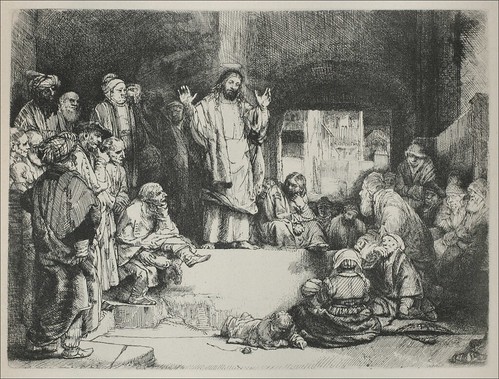
Jesus Preaching (“La Tombe”), Rembrandt (1652), etching
www.rembrandtpainting.net/rmbrndt_etchings/etchings_h/ima...

Transfiguration, Fra Angelico (1439-1443), fresco
www.wga.hu/art/a/angelico/09/cells/06_trans.jpg
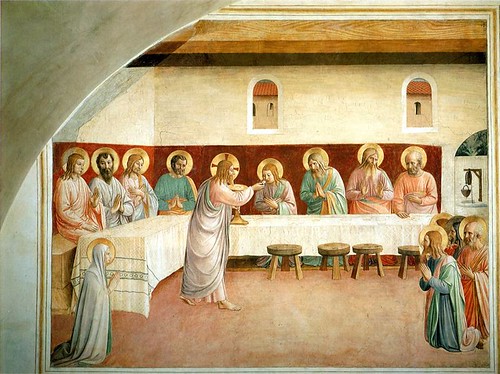
Institution of the Eucharist, Fra Angelico (1450), fresco
www.museumsyndicate.com/images/3/23723.jpg
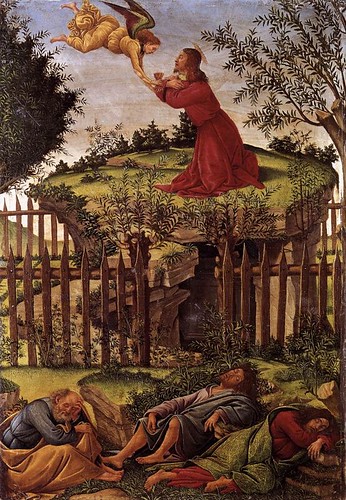
Agony in the Garden, Botticelli (1500), tempera on panel
www.wga.hu/art/b/botticel/91late/12agony.jpg
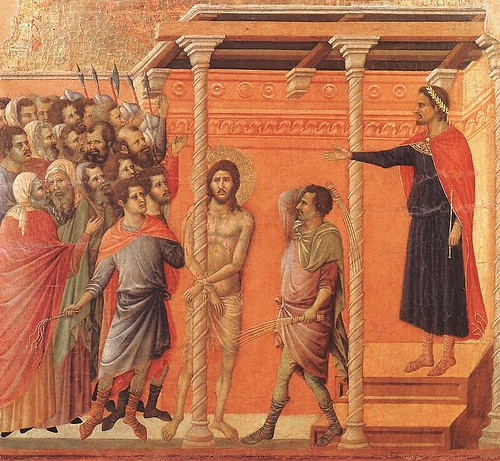
Flagellation, Duccio (1308-11), tempera on wood
www.wga.hu/art/d/duccio/buoninse/maesta/verso_2/verso16.jpg
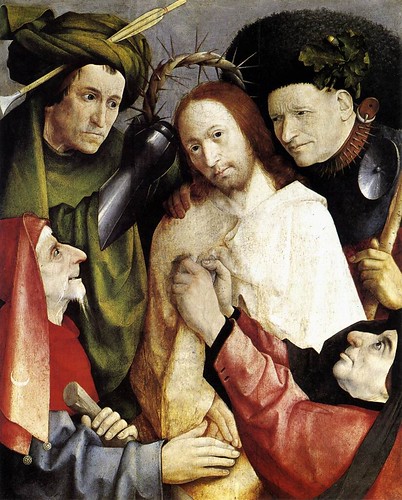
Christ Mocked (Crowning with Thorns), Bosch (1495-1500), oil on wood
www.wga.hu/art/b/bosch/5panels/18mocked.jpg

Christ Carrying the Cross, Bosch (1490), oil on panel
www.ibiblio.org/wm/paint/auth/bosch/carrying/carrying.jpg

Crucifixion, Giotto (1304-06), Giotto, fresco
lh6.ggpht.com/_j4Z6OyB0V_I/R2WSxyfpcNI/AAAAAAAABaY/h5MdV7...

Pieta, Michelangelo (1499)
Photo by Ioja, www.flickr.com/photos/ioja/591752444/
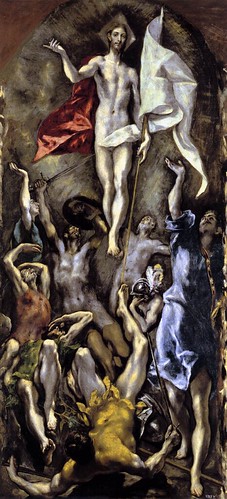
The Resurrection, El Greco, (1577-79), oil on canvas
www.seeingjesus.me/holyimage/5.resurrection/4/12.The%20Re...

Supper at Emmaus, Rembrandt (1648)
www.christusrex.org/www2/art/images/rembrandt03a.jpg

Ascension of Christ, Russian, 16th century icon
campus.belmont.edu/honors/FestalIcons/16thRusAscension.jpg

Pentecost, Duccio (1308-11), tempera on wood
www.wga.hu/art/d/duccio/buoninse/maesta/crown_v/cro_v_h.jpg
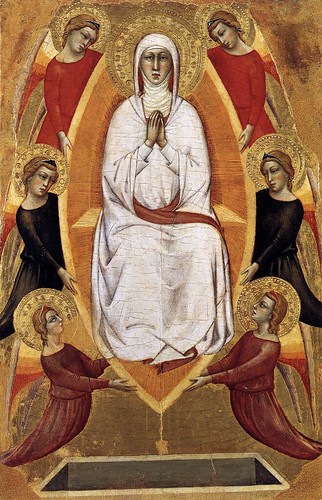
Assumption of the Virgin, Gherarducci (1365), tempera on wood
www.wga.hu/art/g/gherardu/assumpti.jpg
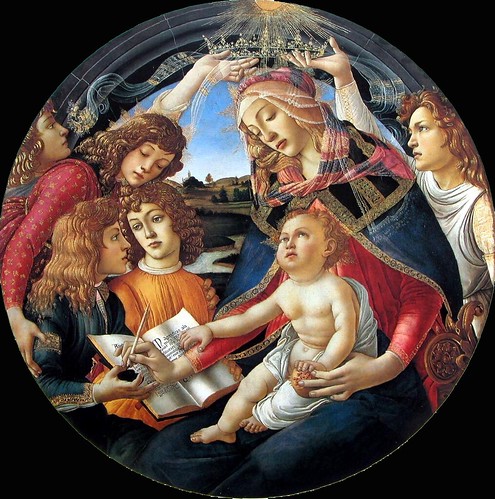
Madonna del Magnificat, Botticelli (1480-81), tempera on panel
muvtor.btk.ppke.hu/reneszansz/Botticelli_1483-85%20Magnif...
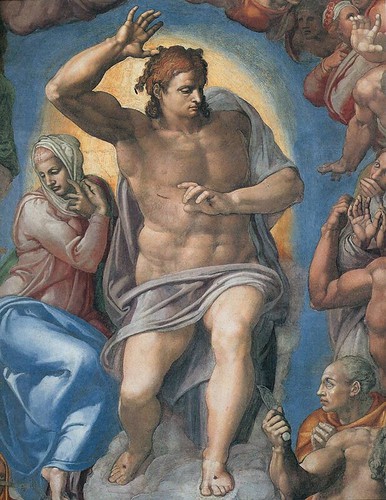
The Last Judgment, Michelangelo (1534-1541), fresco
crossbr.googlepages.com/Michelangelo_Last_Judgement_Chris...
* * *
Recognize any of these? What are your favorite works of art?
Check out Hieronymus Bosch's painting below. Rather contemporary looking, wouldn't you think? This colorful and imaginative painting is over 500 years old.

Christ Carrying the Cross, Bosch (1490), oil on panel
www.ibiblio.org/wm/paint/auth/bosch/carrying/carrying.jpg
Below is Fra Angelico's Transfiguration. Check out the man in the lower-left corner. He's saying, "I must be going crazy – get me out of here."

Transfiguration, Fra Angelico (1439-1443), fresco
www.wga.hu/art/a/angelico/09/cells/06_trans.jpg
Here's another colorful painting: Dürer's Christ Among the Doctors. Each of the faces is most interesting.

Christ Among the Doctors, Dürer (1506), oil on panel
www.dl.ket.org/webmuseum/wm/paint/auth/durer/doctors.jpg
Michelangelo's Pieta is haunting and beautiful. Jesus' mother is portrayed as a young girl, which adds an interesting effect. This looks best at larger size.

Pieta, Michelangelo (1499)
Photo by Ioja, www.flickr.com/photos/ioja/591752444/
Here is the complete list of works I selected:

The Annunciation, Tiepolo (1696-1749), pen and brown ink, brown wash
www.christies.com/LotFinder/LargeImage.aspx?image=/lotfin...

The Visit of Mary to Elisabeth, Giotto (1266-1337), fresco
www.wga.hu/art/g/giotto/padova/2virgin/mary10.jpg

The Nativity, Giotto (1304-06), fresco
www.wga.hu/art/g/giotto/padova/3christ/scenes_1/chris01.jpg

Adoration of the Shepherds, Ghirlandaio (1485), wood
i165.photobucket.com/albums/u59/teamrcia/shepher.jpg

Icon of the Presentation of the Lord in the Temple, Andrei Rublev, 1405, tempera on wood
02varvara.files.wordpress.com/2008/02/entrnce-of-our-lord...

Christ Among the Doctors, Dürer (1506), oil on panel
www.dl.ket.org/webmuseum/wm/paint/auth/durer/doctors.jpg

The Baptism of Jesus Christ, El Greco (1608), oil on canvas
www.wga.hu/art/g/greco_el/12/1208grec.jpg

The Marriage at Cana, Master of the Catholic Kings (1495), oil on panel
lh4.ggpht.com/_OGlO8jr4HxY/SAj-nTw-lZI/AAAAAAAAADk/Rjx5EL...

Jesus Preaching (“La Tombe”), Rembrandt (1652), etching
www.rembrandtpainting.net/rmbrndt_etchings/etchings_h/ima...

Transfiguration, Fra Angelico (1439-1443), fresco
www.wga.hu/art/a/angelico/09/cells/06_trans.jpg

Institution of the Eucharist, Fra Angelico (1450), fresco
www.museumsyndicate.com/images/3/23723.jpg

Agony in the Garden, Botticelli (1500), tempera on panel
www.wga.hu/art/b/botticel/91late/12agony.jpg

Flagellation, Duccio (1308-11), tempera on wood
www.wga.hu/art/d/duccio/buoninse/maesta/verso_2/verso16.jpg

Christ Mocked (Crowning with Thorns), Bosch (1495-1500), oil on wood
www.wga.hu/art/b/bosch/5panels/18mocked.jpg

Christ Carrying the Cross, Bosch (1490), oil on panel
www.ibiblio.org/wm/paint/auth/bosch/carrying/carrying.jpg

Crucifixion, Giotto (1304-06), Giotto, fresco
lh6.ggpht.com/_j4Z6OyB0V_I/R2WSxyfpcNI/AAAAAAAABaY/h5MdV7...

Pieta, Michelangelo (1499)
Photo by Ioja, www.flickr.com/photos/ioja/591752444/

The Resurrection, El Greco, (1577-79), oil on canvas
www.seeingjesus.me/holyimage/5.resurrection/4/12.The%20Re...

Supper at Emmaus, Rembrandt (1648)
www.christusrex.org/www2/art/images/rembrandt03a.jpg

Ascension of Christ, Russian, 16th century icon
campus.belmont.edu/honors/FestalIcons/16thRusAscension.jpg

Pentecost, Duccio (1308-11), tempera on wood
www.wga.hu/art/d/duccio/buoninse/maesta/crown_v/cro_v_h.jpg

Assumption of the Virgin, Gherarducci (1365), tempera on wood
www.wga.hu/art/g/gherardu/assumpti.jpg

Madonna del Magnificat, Botticelli (1480-81), tempera on panel
muvtor.btk.ppke.hu/reneszansz/Botticelli_1483-85%20Magnif...

The Last Judgment, Michelangelo (1534-1541), fresco
crossbr.googlepages.com/Michelangelo_Last_Judgement_Chris...
Recognize any of these? What are your favorite works of art?
Sunday, March 22, 2009
Adler: "When I'm reading a Great Book, I never read faster than 20 pages an hour, and sometimes slower than that."
Here's the author of How To Read A Book on a radio program, talking about how he reads the Great Books.
To a teacher of speed reading: "You can't be a fan of mine and be a speedreader."
"It's terribly important for each of us, for everyone, to find a number of books that are over their heads."
"Sometimes it takes me ten days to read one book, or even longer than ten days, because I'm really working at it; I'm trying to make that book part of myself."
Sunday, March 15, 2009
My next 5 difficult books to read
If I were to choose five authors from the list of Great Books of the Western World to read, my picks would be:
- Homer (800 BC)
- The Bible (600 BC–100AD)
- Plato (427BC–347BC, 80 years)
- Aristotle (384BC–322BC, 62 years)
- Shakespeare (1564–1616, 52 years)
Similarly, my five picks from the Catholic Lifetime Reading Plan would be:
- St. Augustine (354–430, 76 years)
- St. Thomas Aquinas (1225–1274, 49 years)
- Thomas à Kempis (1380–1471, 91 years)
- St. Teresa of Ávila (1515–1582, 67 years)
- St. Thérèse of Lisieux (1873–1897, 24 years)
There's never enough time, and so many other things to do, but I hope that before I die I'll have read the major works of the above authors.
What five difficult authors/books do you plan to read in your lifetime?
Readability Bookmarklet
I quite like this bookmarklet called Readability, which removes clutter from the page and amplifies the font. I like the default settings best (Newspaper Style, Large Size, Wide Margin).
Friday, March 13, 2009
Advice on reading Greek tragedies
Mortimer Adler gives the following two pieces of advice on reading Greek tragedy:
The first is to remember that the essence of tragedy is time, or rather the lack of it. There is no problem in any Greek tragedy that could not have been solved if there had been enough time, but there is never enough ...
The second bit of advice is this. One thing we do know about the staging of Greek playsis that the tragic actors wore buskins on their feet that elevated them several inches above the ground ... But the mebers of the chorus did not wear buskins ... Therefore you should always imagine, when you read the words of the chorus, that the words are spoken by persons of your own stature; while the words spoken by the protagonists proceed from the mouths of giants ...
Capsule Summaries of the Great Books of the Western World
The Great Books of the Western World was a project by Encyclopedia Brittanica to identify the most significant literature in Western culture. You can find the list of authors and titles on Wikipedia, but they don't have descriptions.
So how does one go about choosing what to read?
By using the list below.
This list provides brief descriptions of each work, extracted from the individual Wikipedia pages. This saves you from having to click on each link to see what each book is about.
Perusing the list is an education in itself. You'll be the hit of your next cocktail party (or AP Literature exam).
So how does one go about choosing what to read?
By using the list below.
This list provides brief descriptions of each work, extracted from the individual Wikipedia pages. This saves you from having to click on each link to see what each book is about.
Perusing the list is an education in itself. You'll be the hit of your next cocktail party (or AP Literature exam).
Homer
- The Iliad. The poem concerns events during the ninth year of the Trojan War, the siege of the city of Ilion or Troy, by the Greeks. The plot centers on the Greek warrior Achilles and his anger toward the king of Mycenae, Agamemnon, which proves disastrous for the Greeks.[2] It provides many of the events that the later poems of the Epic Cycle build on, including the death of the Trojan captain Hector.
- The Odyssey. The poem mainly centers on the Greek hero Odysseus (or Ulysses, as he was known in Roman myths) and his long journey home following the fall of Troy. It takes Odysseus ten years to reach Ithaca after the ten-year Trojan War.[2] In his absence, it is assumed he has died, and his wife Penelope and son Telemachus must deal with a group of unruly suitors, called Proci, competing for Penelope's hand in marriage
Aeschylus (Also see Advice on reading Greek tragedies)
- The Suppliant Maidens. The Danaids form the chorus and serve as the protagonists. They flee a forced marriage to their Egyptian cousins. When the Danaides reach Argos, they entreat King Pelasgus to protect them. He refuses pending the decision of the Argive people, who decide in the favor of the Danaids. Danaus rejoices the outcome, and the Danaids praise the Greek gods. Almost immediately, a herald of the Egyptians comes to attempt to force the Danaids to return to their cousins for marriage. Pelasgus arrives, threatens the herald, and urges the Danaids to remain within the walls of Argos. The play ends with the Danaids retreating into the Argive walls, protected
- The Persians. First produced in 472 BCE, it is the oldest surviving play in the history of theatre. It dramatises the Persian response to news of their military defeat at the Battle of Salamis (480 BCE), which was a decisive episode in the Greco–Persian Wars; as such, the play is also notable for being the only extant Greek tragedy that is based on contemporary events.
- Seven Against Thebes. A mythic narrative whose classic statement is found in the play by Aeschylus (467 BC) concerning the battle between the Seven led by Polynices, traditional Theban enemies, and the army of Thebes headed by Eteocles and his supporters.
- Prometheus Bound. The tragedy is based on the myth of Prometheus, a Titan who was punished by the god Zeus for giving fire to mankind. The play is composed almost entirely of speeches and contains little action since its protagonist is chained and immobile throughout. At the beginning, Kratos (Force), Bia (Violence), and Hephaestus the smith-god chain Prometheus to a mountain in the Caucasus and then depart. According to Aeschylus, Prometheus is being punished not only for stealing fire, but also for thwarting Zeus' plan to obliterate the human race. This punishment is especially galling since Prometheus was instrumental in Zeus' victory in the Titanomachy.
- The Oresteia. Agamemnon (Ἀγαμέμνων, Agamemnōn) details the homecoming of Agamemnon, King of Argos, from the Trojan War. Waiting at home for him is his wife, Clytemnestra, who has been planning his murder as revenge for the sacrifice of their daughter, Iphigenia. Furthermore, in the ten years of Agamemnon's absence, Clytemnestra has entered into an adulterous relationship with Aegisthus, Agamemnon's cousin and the scion of a dispossessed branch of the family, who is determined to regain the throne he believes should rightfully belong to him.
Sophocles
- The Oedipus Cycle
- Oedipus the King. Over the centuries, it has come to be regarded by many as the Greek tragedy par excellence.[2] Much of the myth of Oedipus takes place before the opening scene of the play. The protagonist of the tragedy is the son of King Laius and Queen Jocasta of Thebes. After Laius learns from an oracle that "he is doomed/To perish by the hand of his own son," he binds tightly together with a pin the feet of the infant Oedipus and orders Jocasta to kill the infant. Hesitant to do so, she demands a servant to commit the act for her. Instead, the servant abandons the baby in the fields, leaving the baby's fate to the gods. A shepherd rescues the infant and names him Oedipus (or "swollen foot"). Intending to raise the baby himself, but not possessing of the means to do so, the shepherd gives it to a fellow shepherd from a distant land, who spends the summers sharing pastureland with his flocks.The second shepherd carries the baby with him to Corinth, where Oedipus is taken in and raised in the court of the childless King Polybus of Corinth as if he were his own.
- Oedipus at Colonus. The play describes the end of Oedipus' tragic life. Led by Antigone, Oedipus enters the village of Colonus and sits down on a stone. They are approached by a villager, who demands that they leave, because that ground is sacred to the Furies, or Eumenides. Oedipus recognizes this as a sign, for when he received the prophecy that he would kill his father and marry his mother, Apollo also revealed to him that at the end of his life he would die at a place sacred to the Furies, and be a blessing for the land in which he is buried.
- Antigone. The play expands on the Theban legend that predated it and picks up where Aeschylus' Seven Against Thebes ends. Before the beginning of the play's action, Eteocles and Polynices, two brothers leading opposite sides in Thebes' civil war, died fighting each other for the throne. Creon, the new ruler of Thebes, has declared that Eteocles will be honored and Polynices disgraced. The rebel brother's body will not be sanctified by holy rites, and will lie unburied on the battlefield, prey for carrion animals, the harshest punishment at the time. Antigone and Ismene are the sisters of the dead brothers. In the opening of the play, Antigone brings Ismene outside the city gates late at night for a secret meeting: Antigone wants to bury Polynices' body, in defiance of Creon's edict. Ismene refuses to help her, fearing the death penalty, but she is unable to dissuade Antigone from going to bury her brother herself.
- Ajax. It chronicles the fate of the warrior Ajax after the events of the Iliad and the Trojan War. At the onset of the play, Ajax is enraged because Achilles' armor was awarded to Odysseus, rather than him. He vows to kill the Greek leaders who disgraced him. Before he can enact his revenge, though, he is tricked by the goddess Athena into believing that the sheep and cattle that were taken by the Achaeans as spoil are the Greek leaders. He slaughters some of them, and takes the others back to his home to torture, including a ram which he believes to be his main rival, Odysseus.
- Electra. Set in the city of Argos a few years after the Trojan war, it is based around the character of Electra, and the vengeance that she and her brother Orestes take on their mother Clytemnestra and step father Aegisthus for the murder of their father, Agamemnon
- The Trachiniae.The Trachiniae or The Women of Trachis (Greek: Τραχίνιαι / Trachiniai) is a play by Sophocles, notable mainly for the unsympathetic portrayal of Heracles. As in the play Ajax, Sophocles has cast a well-known hero in a negative light.
- Philoctetes. The story takes place during the Trojan War (after the events of the Iliad, and before the Trojan Horse). It describes the attempt by Neoptolemus and Odysseus to bring the disabled Philoctetes with them to Troy.
Euripides
- Rhesus. Rhesus takes place during the Trojan War, on the night when Odysseus and Diomedes sneak into the Trojan camp. This is the same event depicted in book 10 of Homer's the Iliad.
- Medea. The plot largely centers on the protagonist in her struggle with the world, and the revenge she brings about against her husband Jason who has betrayed her for another woman, the princess Glauce. For this reason it is often seen as the most Sophoclean of Euripides' extant plays.
- Hippolytus. Euripides revisits the myth in Hippolytos Stephanophoros ("Hippolytus who wears a crown"),[4] this time with a modest Phaedra who fights her sexual appetites. The surviving play offers a much more even-handed and psychologically complex treatment of the characters than is commonly found in traditional retelling of myths.
- Alcestis. Its ambiguous, tragicomic tone—which could be "cheerfully romantic" or "bitterly ironic"—has earned it the label of "problem play."[3]
- Heracleidae. It follows the children of Heracles (known as the Heracleidae), as they seek protection from Eurystheus
- The Suppliants. The play begins with Adrastus and the Argive mothers seeking help from Aithra and her son Theseus within the Temple of Demeter. Theseus feels pity for them, and with the consent of the Athenian people decides to help. After it has become clear that Creon will not give up the bodies, the Athenian army must take them by force. In the end, the dead are finally laid to rest.
- Trojan Women. Euripides' play follows the fates of the women of Troy after their city has been sacked, their husbands killed, and as their remaining families are about to be taken away as slaves. However, it begins first with the gods Athena and Poseidon discussing ways to punish the Greek armies because they condoned Ajax the Lesser for dragging Cassandra away from Athena's temple. What follows shows how much the Trojan women have suffered as their grief is compounded when the Greeks dole out additional deaths and divide their shares of women.
- Ion. It follows the orphan Ion in the discovery of his origins.
- Helen. Helen receives word from the exiled Greek Teukros that Menelaus has drowned, putting her in the perilous position of being available for Theoclymenos to marry, and she consults Theonoe, sister to the king, to find out her husband's fate.
- Andromache. It follows Andromache during her life as a slave, years after the events of the Trojan War.
- Electra. The play begins by introducing Clytemnestra and Agamemnon's daughter, Electra. Electra was married off to a farmer, amidst fears that if she remained in the royal household and wed a nobleman, their children would be more likely to try to avenge Agamemnon's death. The man Electra is married to, however, is kind to her and has taken advantage of neither her family name nor her virginity. In return Electra helps the peasant with household chores. Despite her appreciation for her peasant husband, Electra resents being cast out of her house and her mother's loyalty to Aegisthus. Agamemnon and Clytemnestra's son, Orestes, was taken out of the country and put under the care of the king of Phocis, where he became friends with the king's son Pylades.
- Bacchantes. The tragedy is based on the mythological story of King Pentheus of Thebes and his mother Agavë, and their punishment by the god Dionysus (who is Pentheus' cousin) for refusing to worship him.
- Hecuba. It depicts Hecuba's grief over the loss of a daughter, and the revenge she takes over the loss of a son. Taking place near the same time is The Trojan Women, another play by Euripides.
- Heracles Mad. While Heracles is in the underworld obtaining Cerberus for one of his labors, his father Amphitryon, wife Megara, and children are sentenced to death in Thebes, Greece by Lycus. Heracles arrives in time to save them, however the goddesses Iris and Madness (personified) cause him to kill his wife and children in a frenzy.
- Phoenician Women. The title refers to the Greek chorus, which is composed of Phoenician women on their way to Delphi who are trapped in Thebes by the war. Patriotism is a significant theme in the story, as Polynices talks a great deal about his love for the city of Thebes but has brought an army to destroy it; Creon is also forced to make a choice between saving the city and saving the life of his son.
- Orestes. Follows the events of Orestes after he had murdered his mother
- Iphigeneia in Tauris. "Iphigenia among the Taurians" is often described as a romance, a melodrama or an escape play. Contrary to Iphigeneia's dream, then, Orestes is still alive and on his way to Tauris with Pylades to steal the sacred statue. They have no idea that Iphigeneia is there. They are captured by Taurian guards and brought to the temple to be killed, as is customary
- Iphigeneia at Aulis. The play revolves around Agamemnon, the leader of the Greek coalition before and during the Trojan War, and his decision to sacrifice his daughter Iphigenia to allow his troops to set sail and preserve their honour by doing battle against Troy.
- CyclopsIt is a comical burlesque-like play on the same story depicted in book nine of The Odyssey by Homer. Odysseus has lost his way on the voyage home from the Trojan War. He and his hungry crew make a stop in Sicily at Mount Aetna, which is inhabited by Cyclopes. They come upon the Satyrs and their father Silenus, who have been separated from their god Dionysus and enslaved by a Cyclops.
Aristophanes
- The Acharnians. The play is notable for its absurd humour, its imaginative appeal for an end to the Peloponnesian War and for the author's spirited response to his prosecution the year before by Cleon. The play begins with Dikaiopolis sitting all alone on the Pnyx (the hill where the Athenian Assembly or ecclesia regularly meets to discuss matters of state). He is middle-aged, he looks bored and frustrated and soon he begins to vent his thoughts and feelings to the audience.
- The Knights. The play is above all else an unbridled attack on Cleon. Most of the play consists of a long series of contests, in which the Sausage-Seller and the Paphlagonian each try to show that they will serve their master The People better than their rival can or has..
- The Clouds. A comedy lampooning the sophists and the intellectual trends of late fifth-century Athens. Many also find the play to be quite funny as an irreverent satire of pretentious academia.
- The Wasps. As in his other early plays, Aristophanes pokes satirical fun at the demagogue Cleon but in The Wasps he also ridicules one of the Athenian institutions that provided Cleon with his power-base: the law courts. The play has been thought to exemplify the conventions of Old Comedy better than any other play and it has been considered to be one of the world's greatest comedies.[3]
- Peace. As with all Aristophanic plays, 'Peace' involves much innuendo, scatology and obscenity, and indeed the play opens with two slaves onstage, working dung into 'cakes' in a mixing bowl.
- The Birds. Pisthetairos and Euelpides, frustrated with life in wartime Athens, search for Tereus, a king who had been changed into a hoopoe, in the realm of the birds in the sky. After reaching the sky and meeting a descendant of Tereus, they convince the birds to help them create Nephelokokkygia (or Nephelococcygia, "Cloudcuckooland"). Pisthetairos and Euelpides are given feathers and wings by the birds, and Pisthetairos quickly takes over the new city as a demagogue and tyrant.
- The Frogs. The Frogs tells the story of the god Dionysus, despairing of the state of Athens' tragedians, and allegedly recovering from the disastrous Battle of Arginusae. He travels to Hades to bring Euripides back from the dead. He brings along his slave Xanthias, who is smarter, stronger, more rational, more prudent, and braver than Dionysus. The play opens as Xanthias and Dionysus argue over what kind of complaints Xanthias can use to open the play comically.
- Lysistrata ("She who disbands armies"). It is a comic account of one woman's extraordinary mission to end The Peloponnesian War. Lysistrata convinces the women of Greece to withhold sexual privileges from their husbands as a means of forcing the men to negotiate a peace, a strategy however that inflames the battle between the sexes. The play is notable for its exposé of sexual relations in a male-dominated society and for its use of both double entendre and explicit obscenities.
- Thesmophoriazusae. Sometimes also called "The Poet and the Women", it is now considered one of Aristophanes' most brilliant parodies of Athenian society,[3] with a particular focus on the subversive role of women in a male-dominated society, the vanity of contemporary poets, such as the tragic playwrights Euripides and Agathon, and the shameless, enterprising vulgarity of an ordinary Athenian, as represented in this play by the protagonist, Mnesilochus. The play is also notable for Aristophanes' free adaptation of key structural elements of Old Comedy and for the absence of the anti-populist and anti-war comments that pepper his earlier work.[4] It was produced in the same year as Lysistrata, another play with a sexual theme.
- Ecclesiazousae ("Assemblywomen"). A play similar in theme to Lysistrata in that a large portion of the comedy comes from women involving themselves in politics. This play is much more infused with gender issues than Lysistrata is. The play concerns a group of women, the leader of which is Praxagora. She has decided that the women must convince the men to give them control of Athens, because they could rule it better than they have been. The women, in the guise of men, sneak into the assembly and vote the measure, convincing some of the men to vote for it because it is the only thing they have not tried.
- Plutus ("Wealth"). A political satire on contemporary Athens, it features the personified god of wealth Plutus. Reflecting the development of Old Comedy towards New Comedy, it uses such familiar character types as the stupid master and the insubordinate slave to attack the morals of the time.
Herodotus
- The History. Considered the first work of history in Western literature, the Histories tells the story of the Greco-Persian Wars between the Achaemenid Empire and the Greek city-states in the 5th century BC. Herodotus travelled extensively around the ancient world, conducting interviews and collecting stories for his boo
Thucydides
- The History of the Peloponnesian War. An account of the Peloponnesian War in Ancient Greece, fought between the Peloponnesian League (led by Sparta) and the Delian League (led by Athens). It was written by Thucydides, an Athenian general who served in the war. It is widely considered a classic and regarded as one of the earliest scholarly works of history.
Plato
- Charmides. A dialogue in which Socrates engages a handsome and popular boy in a conversation about the meaning of sophrosyne, a Greek word usually translated into English as "temperance", "self-control", or "restraint". As is typical with Platonic dialogues, the two never arrive at a completely satisfactory definition, but the discussion nevertheless raises many important points.
- Lysis. A dialogue which discusses the nature of friendship. The main characters are Socrates, the boys Lysis and Menexenus who are friends, as well as Hippothales, who is in unrequited love with Lysis and therefore, after the initial conversation, hides himself behind the surrounding listeners.
- Laches. A Socratic dialogue written by Plato, and concerns the topic of courage. Lysimachus, son of Aristides, and Melesias, son of Thucydides (not the historian Thucydides), request advice from Laches and Nicias on whether or not they should have their sons (who are named after their famous grandfathers) trained to fight in armor.
- Protagoras. The main argument is between the elderly Protagoras, a celebrated sophist, and Socrates. The discussion takes place at the home of Callias, who is host to Protagoras while he is in town, and concerns a familiar theme in the dialogues: the teachability of virtue. The dialogue is perhaps most remarkable for the sheer number of people said to be in attendance: a total of twenty-one are named as present.
- Euthydemus. A dialogue which satirizes the logical fallacies of the Sophists. It describes a visit paid by Socrates and various youths to two brothers, Euthydemus and Dionysodorus, both of whom are prominent Sophists. The main purpose of Euthydemus is to contrast Socratic argumentation and education with those of the Sophism, to the detriment of the latter.
- Cratylus. In the dialogue, Socrates is asked by two men, Cratylus and Hermogenes, to tell them whether names are "conventional" or "natural", that is, whether language is a system of arbitrary signs or whether words have an intrinsic relation to the things they signify. In doing this, Cratylus became one of the earliest philosophical texts of the Classical Greek period to deal with matters of etymology and linguistics.
- Phaedrus. It is often considered one of Plato's literary high points. Although ostensibly about the topic of love, the discussion in the dialogue revolves around the art of rhetoric and how it should be practiced, and dwells on subjects as diverse as reincarnation and erotic love.
- Ion. Socrates discusses with the title character the question of whether the rhapsode, a professional performer of poetry, gives his performance on account of his skill and knowledge or by virtue of divine possession.
- Symposium. It is a discussion on the nature of love, taking the form of a group of speeches, both satirical and serious, given by a group of men at a symposium or a wine drinking gathering at the house of the tragedian Agathon at Athens. The structure of Symposium is of a story within a story within a story.
- Meno. Written in the Socratic dialectic style, it attempts to determine the definition of virtue, or arete, meaning in this case virtue in general, rather than particular virtues (e.g. justice, temperance, etc.).
- Euthyphro. It features Ancient Greek philosopher Socrates and Euthyphro, a man known for claiming to be a religious expert. They attempt to pinpoint a definition for piety.
- Apology. Plato's version of the speech given by Socrates as he defends himself against the charges of being a man "who corrupted the young, refused to worship the gods, and created new deities".
- Crito. A short but important dialogue. It is a conversation between Socrates and his wealthy friend Crito regarding justice (dikē), injustice (adikia), and the appropriate response to injustice. Socrates thinks that injustice may not be answered with injustice, and refuses Crito's offer to finance his escape from prison. This dialogue contains an ancient statement of the social contract theory of government.
- Phaedo. One of the great dialogues of his middle period, along with the Republic and the Symposium. The Phaedo, which depicts the death of Socrates, is also Plato's fourth and last dialogue (the first three being Euthyphro, Apology, and Crito) to detail the philosopher's final days.
- Gorgias. An important Socratic Dialogue in which Plato sets the rhetorician, whose specialty is persuasion, in opposition to the philosopher, whose specialty is dissuasion, or refutation.
- The Republic. It is one of the most influential works of philosophy and political theory, and Plato's best known work.[2][3] In Plato's fictional dialogues the characters of Socrates as well as various Athenians and foreigners discuss the meaning of justice and examine whether the just man is happier than the unjust man by imagining a society ruled by philosopher-kings and the guardians. The dialogue also discusses the role of the philosopher, Plato's Theory of Forms, the place of poetry, and the immortality of the soul. [4]
- Timaeus. The work puts forward speculation on the nature of the physical world.
- Critias. Contains the story of the mighty island kingdom Atlantis and its attempt to conquer Athens, which failed due to the ordered society of the Athenians.
- Parmenides. It is perhaps Plato's most challenging dialogue. The Parmenides purports to be an account of a meeting between the two great philosophers of the Eleatic school, Parmenides and Zeno of Elea, and a young Socrates. The occasion of the meeting was the reading by Zeno of his treatise defending Parmenidean monism against those partisans of plurality who asserted that Parmenides' supposition that there is a one gives rise to intolerable absurdities and contradictions.
- Theaetetus. Concerning the nature of knowledge. The framing of the dialogue begins when Euclides tells his friend Terpsion that he had written a book many years ago based on what Socrates had told him of a conversation he'd had with Theaetetus when [Theaetetus] was quite a young man.
- Sophist. After he criticized his own Theory of Forms in the Parmenides, Plato proceeds in the Sophist with a new conception of the Forms, more mundane and down-to-earth, and makes more clear the epistemological and metaphysical puzzles of the Parmenides. Furthermore, he shows his expertise in Dialectic, as he applies it in this Dialogue in order to define the Sophist. Moreover, he solves the puzzle of the false and the right opinion, as well as of the justified true belief that had been inquired in the Theaetetus.
- Statesman. The text is a dialogue between Socrates and the mathematician Theodorus, another student named Socrates (referred to as Young Socrates), and an unknown philosopher expounding the ideas of the statesman.
- Philebus. The dialogue's central question concerns the relative value of pleasure and knowledge, and produces a model for thinking about how complex structures are developed.
- Laws. Plato's last and longest dialogue. The question asked at the beginning is not "What is law?" as one would expect. That is the question of the Minos. The first question is rather, "Who is given the credit for laying down your laws?"
- The Seventh Letter. Account of Plato's involvement with Dionysius II (Dionysius the Younger), tyrant of Syracuse. The Seventh Letter also has a detailed exposition of Plato's ideas about the Forms.
Aristotle
- Categories. Enumerates all the possible kinds of thing which can be the subject or the predicate of a proposition.
- On Interpretation. One of the earliest surviving philosophical works in the Western tradition to deal with the relationship between language and logic in a comprehensive, explicit, and formal way.
- Prior Analytics. Aristotle's work on deductive reasoning, part of his Organon, the instrument or manual of logical and scientific methods.
- Posterior Analytics. Deals with demonstration, definition, and scientific knowledge.
- Topics. Aristotle's treatise on the art of dialectic—the invention and discovery of arguments in which the propositions rest upon commonly-held opinions or endoxa.
- On Sophistical Refutations. On "verbal fallacies" and "material fallacies".
- Physics. A key text in the philosophy of Aristotle. The work is a collection of treatises or lessons that deals with the most general (philosophical) principles of moving things, both living and non-living, rather than physical theories (in the modern sense) or investigations of the particular contents of the universe. It establishes the basis for any scientist of any age to study the world of change. Change, or movement, or motion (kinesis) is the chief subject of the work.
- On Generation and Corruption. Whether things come into being through causes, through some prime material, or whether everything is generated purely through "alteration." From this important work Aristotle gives us two of his most remembered contributions. First, the Four Causes and also the Four Elements (earth, wind, fire and water). He uses these four elements to provide an explanation for the theories of other Greeks concerning atoms, an idea Aristotle considered absurd.
- Meteorology. Theories about the earth sciences. These include early accounts of water evaporation, weather phenomena, and earthquakes.
- Metaphysics. One of the principal works of Aristotle and the first major work of the branch of philosophy with the same name. The principal subject is "being qua being", or being understood as being. It examines what can be asserted about anything that exists just because of its existence and not because of any special qualities it has. Also covered are different kinds of causation, form and matter, the existence of mathematical objects, and God.
- On the Soul. A major treatise by Aristotle on the nature of living things. His discussion centres on the kinds of souls possessed by different kinds of living things, distinguished by their different operations. Thus plants have the capacity for nourishment and reproduction, the minimum that must be possessed by any kind of living organism. Lower animals have, in addition, the powers of sense-perception and self-motion (action). Humans have all these as well as intellect.
- Minor biological works
- History of Animals. A zoological natural history text. The work consists of lengthy descriptions (Greek: historiai) of countless species of fish, shellfish, and other animals and their anatomies.
- On the Parts of Animals
- On the Motion of Animals. General principles of motion in animals.
- On the Gait of Animals On the details of gait and movement in various species of animals. Aristotle's approach to the subject is to ask "why some animals are footless, others bipeds, others quadrupeds, others polypods, and why all have an even number of feet, if they have feet at all; why in fine the points on which progression depends are even in number." It's a good example of the way he brought teleological presumptions to empirical studies.
- On the Generation of Animals
- Nicomachean Ethics. On virtue and moral character, which plays a prominent role in defining Aristotelian ethics. It consists of ten books based on notes said to be from his lectures at the Lyceum which were either edited by or dedicated to Aristotle's son, Nicomachus.
- Politics. Political philosophy. In the first book, Aristotle discusses the origin of the state and its composition as political community (koinonia politike). This leads him into the issues of slavery, household economics and natural and unnatural modes of acquiring goods, or the theory and practice of "wealth-getting".
- The Athenian Constitution. The surviving manuscript begins in the middle of a sentence dealing with Cylon; some of the fragments deal with earlier Athenian history.
- Rhetoric. On the art of persuasion. The Rhetoric is regarded by most rhetoricians as "the most important single work on persuasion ever written."
- Poetics. Aims to give an account of what he calls 'poetry' (for him, the term includes the lyric, the epos, and the drama). Aristotle attempts to explain 'poetry' through 'first principles' and by discerning its different genres and component elements. His analysis of tragedy constitutes the core of his discussion.[1] "Although Aristotle's Poetics is universally acknowledged in Western critical tradition," Marvin Carlson explains, "almost every detail about his seminal work has aroused divergent opinions."[2]
Hippocrates
- Works . Textbooks, lectures, research, notes and philosophical essays on various subjects in medicine, in no particular order.
Galen
- On the Natural Faculties. Galen was a prominent Roman physician and philosopher of Greek origin,[1] and probably the most accomplished medical researcher of the Roman period.
Euclid
- The Thirteen Books ofEuclid's Elements. It comprises a collection of definitions, postulates (axioms), propositions (theorems and constructions), and mathematical proofs of the propositions. The thirteen books cover Euclidean geometry and the ancient Greek version of elementary number theory.
Archimedes
- On the Sphere and Cylinder. It most notably details how to find the surface area of a sphere and the volume of the contained ball and the analogous values for a cylinder, and was the first to do so.[2]
- Measurement of a Circle. This is a short work consisting of three propositions. It is written in the form of a correspondence with Dositheus of Pelusium, who was a student of Conon of Samos.
- On Conoids and Spheroids. This is a work in 32 propositions addressed to Dositheus. In this treatise Archimedes calculates the areas and volumes of sections of cones, spheres, and paraboloids.
- On Spirals. Although Archimedes did not discover the Archimedean spiral, he employed it in this book to square the circle and trisect an angle.[1]
- On the Equilibrium of Planes. In this work Archimedes explains the Law of the Lever, stating: "Magnitudes are in equilibrium at distances reciprocally proportional to their weights."
- The Sand-Reckoner. A work by Archimedes in which he set out to determine an upper bound for the number of grains of sand that fit into the universe. In order to do this, he had to estimate the size of the universe according to the then-current model, and invent a way to talk about extremely large numbers. The work, about 8 pages long in translation, is addressed to the Syracusan king Gelo II (son of Hiero II) and is probably the most accessible work of Archimedes; in some sense, it is the first research-expository paper.[1]
- The Quadrature of the Parabola. A treatise on geometry, written by Archimedes in the 3rd century B.C. Written as a letter to his friend Dositheus, the work presents 24 propositions regarding parabolas, culminating in a proof that the area of a parabolic segment (the region enclosed by a parabola and a line) is 4/3 that of a certain inscribed triangle.
- On Floating Bodies. Spells out the law of equilibrium of fluids, and proves that water will adopt a spherical form around a center of gravity
- Book of Lemmas. Fifteen propositions on circles.
- The Method Treating of Mechanical Problems. In this work Archimedes uses infinitesimals, and shows how breaking up a figure into an infinite number of infinitely small parts can be used to determine its area or volume. Archimedes may have considered this method lacking in formal rigor, so he also used the method of exhaustion to derive the results. As with The Cattle Problem, The Method of Mechanical Theorems was written in the form of a letter to Eratosthenes in Alexandria.
Apollonius of Perga
- On Conic Sections. Apollonius of Perga was a Greek geometer and astronomer noted for his writings on conic sections. His innovative methodology and terminology, especially in the field of conics, influenced many later scholars including Ptolemy, Francesco Maurolico, Isaac Newton, and René Descartes.
Nicomachus of Gerasa
- Introduction to Arithmetic. Contains both philosophical prose and very basic mathematical ideas. Nicomachus refers to Plato quite often, and wrote about how philosophy can only be possible if one knows enough maths. Nicomachus describes how natural numbers and basic mathematical ideas are eternal and unchanging, and in an incorporeal realm.
Lucretius
- On the Nature of Things. A first century BCE poem by the Roman poet and philosopher Lucretius with the goal of explaining Epicurean philosophy to a Roman audience. The poem is divided into six books, and concentrates heavily on Epicurean physics. It deals with the principles of atomism; the nature of the mind and soul; explanations of sensation and thought; the development of the world and its phenomena; and explains a variety of celestial and terrestrial phenomena. The poem grandly proclaims the reality of our role in a universe which is ruled by chance, with no interference from gods. It is a statement of personal responsibility in a world in which everyone is driven by hungers and passions with which they were born and do not understand.
Epictetus
- The Discourses. A series of extracts of the teachings of the Stoic philosopher Epictetus.
Marcus Aurelius
- The Meditations. A series of personal writings by Marcus Aurelius setting forth his ideas on Stoic philosophy. Marcus Aurelius wrote the 12 books of the Meditations in "highly-educated" Koine Greek[1] as a source for his own guidance and self-improvement.
Virgil
- The Eclogues. Imitating the Greek Bucolica ("on care of cattle", so named from the poetry's rustic subjects) by Theocritus, Virgil created a Roman version partly by offering a dramatic and mythic interpretation of revolutionary change at Rome in the turbulent period between roughly 44 and 38 BC.
- The Georgics. Its ostensible subject is rural life and farming. It is generally described as didactic poetry.
- The Aeneid. A Latin epic poem that tells the legendary story of Aeneas, a Trojan who traveled to Italy, where he became the ancestor of the Romans. The first six of the poem's twelve books tell the story of Aeneas' wanderings from Troy to Italy, and the poem's second half tells of the Trojans' ultimately victorious war upon the Latins, under whose name Aeneas and his Trojan followers are destined to be subsumed.
Plutarch
- The Lives of the Noble Grecians and Romans. A series of biographies of famous men, arranged in tandem to illuminate their common moral virtues or failings. It is a work of considerable importance, not only as a source of information about the individuals biographized, but also about the times in which they lived.
P. Cornelius Tacitus
- The Annals. A history book covering the reign of the four Roman Emperors succeeding to Caesar Augustus. The parts of the work that survived from antiquity cover (most of) the reigns of Tiberius and Nero.
- The Histories. Covers the Year of Four Emperors following the downfall of Nero, the rise of Vespasian, and the rule of the Flavian Dynasty (69–96) up to the death of Domitian.
Ptolemy
- The Almagest ("The Great Book"). A mathematical and astronomical treatise proposing the complex motions of the stars and planetary paths.
Nicolaus Copernicus
- On the Revolutions of Heavenly Spheres. The seminal work on heliocentric theory and the masterpiece of astronomer Nicolaus Copernicus. The book offered an alternative model of the universe to the Ptolemaic system that had been widely accepted since ancient times.
Johannes Kepler
- Epitome of Copernican Astronomy. An astronomy textbook, Epitome became Kepler's most influential work. It contained all three laws of planetary motion and attempted to explain heavenly motions through physical causes(Books IV - V)
- The Harmonies of the World. In the work Kepler discusses harmony and congruence in geometrical forms and physical phenomena. The final section of the work relates his discovery of the so-called "Third Law" of planetary motion.(Book V)
Plotinus
- The Six Enneads. The collection of writings of Plotinus, edited and compiled by his student Porphyry. Plotinus was a student of Ammonius Saccas and they were founders of Neoplatonism. His work, through Augustine of Hippo, and therefore subsequent Christian and Muslim thinkers, has greatly influenced Western and Near-Eastern thought.
Augustine of Hippo
- The Confessions. The work outlines Augustine's sinful youth and his conversion to Christianity. It is widely seen as the first Western autobiography ever written, and was an influential model for Christian writers throughout the following 1000 years of the Middle Ages.
- The City of God. Deals with issues concerning God, martyrdom, Jews, and other Christian philosophies. Augustine wrote the treatise to explain Christianity's relationship with competing religions and philosophies, and to the Roman government with which it was increasingly intertwined.
- On Christian Doctrine. A theological text that describes how to interpret and teach the Scriptures. By writing this text, St. Augustine set three tasks on Christian teachers and preachers: to discover the truth in the contents of the Scriptures, to teach the truth from the Scriptures, and to defend scriptural truth when it was attacked.
Thomas Aquinas
- Summa Theologica. The most famous work of Thomas Aquinas, although it was never finished. It was intended as a manual for beginners as a compilation of all of the main theological teachings of that time. It summarizes the reasonings for almost all points of Christian theology in the West, which, before the Protestant Reformation, subsisted solely in the Roman Catholic Church. The Summa's topics follow a cycle: the existence of God, God's creation, Man, Man's purpose, Christ, the Sacraments, and back to God.(First part complete, selections from second part)
- Summa Theologica(Selections from second and third parts and supplement)
Dante Alighieri
- The Divine Comedy. Widely considered the central epic poem of Italian literature, and is seen as one of the greatest works of world literature.[1] The poem's imaginative and allegorical vision of the Christian afterlife is a culmination of the medieval world-view as it had developed in the Western Church.
Geoffrey Chaucer
- Troilus and Criseyde. Retells the tragic love story of Troilus, a Trojan prince, and Criseyde.
- The Canterbury Tales. A collection of stories (two of them in prose, the rest in verse). The tales are contained inside a frame tale and told by a collection of pilgrims on a pilgrimage from London Borough of Southwark to visit the shrine of Saint Thomas Becket at Canterbury Cathedral.[1] The Canterbury Tales are written in Middle English.
Niccolò Machiavelli
- The Prince. The Prince examines the acquisition, perpetuation, and use of political power in the western world. Not intending his writing to be a scholarly treatise on political theory, Machiavelli wrote The Prince to prove his proficiency in the art of the state, offering advice on how a prince might gain and keep power.
Thomas Hobbes
- Leviathan. The book concerns the structure of society and legitimate government, and is regarded as one of the earliest and most influential examples of social contract theory.
François Rabelais
- Gargantua and Pantagruel. It is the story of two giants, a father (Gargantua) and his son (Pantagruel) and their adventures, written in an amusing, extravagant, satirical vein. There is much crudity and scatological humor as well as a large amount of violence. Long lists of vulgar insults fill several chapters.
Michel Eyquem de Montaigne
- Essays. Montaigne essentially invented the literary form of essay. Montaigne's stated goal in his book is to describe man, and especially himself, with utter frankness. He finds the great variety and volatility of human nature to be its most basic features. A typical quote is "I have never seen a greater monster or miracle than myself."
William Shakespeare
- The First Part of King Henry the Sixth. A history play. The play follows the available historical chronicles fairly closely, while making occasional changes for dramatic effect.
- The Second Part of King Henry the Sixth. It is the second part of the trilogy on Henry VI, and often grouped together with Richard III as a tetralogy on The Wars of the Roses—the success of which established Shakespeare's reputation as a playwright.
- The Third Part of King Henry the Sixth. The play is considered the best of the three Henry VI plays and evidence of Shakespeare's ability to produce scenes of moving drama
- The Tragedy of Richard the Third. Depicts the Machiavellian rise to power and subsequent short reign of Richard III of England.
- The Comedy of Errors. It is his shortest play and one of his most farcical, with a major part of the humour coming from slapstick and mistaken identity, in addition to puns and wordplay.
- Titus Andronicus. It depicts a Roman general who is engaged in a cycle of revenge with his enemy Tamora, the Queen of the Goths. The play is by far Shakespeare's bloodiest work. It lost popularity during the Victorian era because of its gore, and has only recently begun to revive its fortunes.
- The Taming of the Shrew. The main plot depicts the courting of Petruchio, a gentleman of Verona, and Katherina, the headstrong, obdurate, and eponymous shrew. The play's misogynistic elements have become the subject of considerable controversy, particularly among modern audiences and readers.
- The Two Gentlemen of Verona. It has the smallest cast of any of Shakespeare's plays, and is the first of his plays in which a heroine dresses as a boy. It deals with the themes of friendship and infidelity. The highlight of the play is considered by some to be Launce, the clownish servant of Proteus, and his dog Crab, to whom "the most scene-stealing non-speaking role in the canon" has been attributed.
- Love's Labour's Lost. Love's Labour's is often thought of as Shakespeare's most flamboyantly intellectual play. The King of Navarre and three noble companions, Berowne, Dumaine, and Longaville, taking an oath to devote themselves to three years of study, promising not to give in to the company of women — Berowne somewhat more hesitantly than the others.
- Romeo and Juliet. About two young "star-cross'd lovers"[1] whose untimely deaths ultimately unite their feuding families.
- The Tragedy of King Richard the Second. A history play based on the life of King Richard II of England.
- A Midsummer-Night's Dream. A romantic comedy portraying the adventures of four young Athenian lovers and a group of amateur actors, their interactions with the Duke and Duchess of Athens, Theseus and Hippolyta, and with the fairies who inhabit a moonlit forest.
- The Life and Death of King John. A history play dramatizing the reign of King John of England (ruled 1199–1216).
- The Merchant of Venice. Bassanio, a young Venetian, would like to travel to Belmont to woo the beautiful and wealthy heiress Portia. He approaches his friend Antonio, a merchant, for three thousand ducats needed to subsidize his traveling expenditures as a suitor for three months. As all of Antonio's ships and merchandise are busy at sea, he promises to cover a bond, so Bassanio turns to the moneylender/usurer Shylock and names Antonio as the loan’s guarantor.
- The First Part of King Henry the Fourth. Depicts a span of history that begins with Hotspur's battle at Homildon against the Douglas late in 1402 and ends with the defeat of the rebels at Shrewsbury in the middle of 1403.[1] From the start it has been an extremely popular play both with the public and the critics.
- The Second Part of King Henry the Fourth. The third part of a tetralogy, preceded by Richard II and Henry IV, Part 1 and succeeded by Henry V.
- Much Ado About Nothing. The story concerns a pair of lovers named Claudio and Hero who are due to be married in a week. To pass the time before their wedding day they conspire with Don Pedro, the prince of Aragon, to trick their friends, Beatrice and Benedick, into confessing their love for one another. The prince's illegitimate brother Don John, however, jealous of both Don Pedro's power and his affection for Claudio, plans to sabotage the coming wedding.
- The Life of King Henry the Fifth. It is based on the life of King Henry V of England, and focuses on events immediately before and after the Battle of Agincourt (1415) during the Hundred Years' War. In Henry V, the young prince has become a mature man and embarks on an attempted conquest of France.
- Julius Caesar. It portrays the conspiracy against the Roman dictator of the same name, his assassination and its aftermath.
- As You Like It. As You Like It follows its heroine Rosalind as she flees persecution in her uncle's court to find safety and eventually love in the Forest of Arden. Historically, critical response has varied, with some critics finding the work of lesser quality than other Shakespearean works and some finding the play a work of great merit. The play features one of Shakespeare's most famous and oft-quoted soliloquies, "All the world's a stage" and the phrase "too much of a good thing."
- Twelfth Night. Like many of Shakespeare's comedies, this one centres on mistaken identity. The leading character, Viola, is shipwrecked on the shores of Illyria during the opening scenes. She loses contact with her twin brother, Sebastian, whom she believes dead. Posing as a boy and masquerading as a young page under the name Cesario, she enters the service of Duke Orsino. Orsino is in love with the bereaved Lady Olivia, whose father and brother have recently died, and who will have nothing to do with any suitors, the Duke included. Orsino decides to use "Cesario" as an intermediary. Olivia, believing Viola to be a man, falls in love with this handsome and eloquent messenger. Viola, in turn, has fallen in love with the Duke, who also believes Viola is a man, and who regards her as his confidant.; or,What You Will
- The Tragedy of Hamlet, Prince of Denmark. The play, set in Denmark, recounts how Prince Hamlet exacts revenge on his uncle Claudius, who has murdered Hamlet's father, the King, and then taken the throne and married Hamlet's mother. The play vividly charts the course of real and feigned madness—from overwhelming grief to seething rage—and explores themes of treachery, revenge, incest, and moral corruption.
- The Merry Wives of Windsor. It features the fat knight Sir John Falstaff, and is Shakespeare's only play to deal exclusively with contemporary Elizabethan era English middle class life.
- Troilus and Cressida. The play ends instead on a very bleak note with the death of the noble Trojan Hector and destruction of the love between Troilus and Cressida. Throughout the play, the tone lurches wildly between bawdy comedy and tragic gloom, and readers and theatre-goers have frequently found it difficult to understand how one is meant to respond to the characters. However, several characteristic elements of the play (the most notable being its constant questioning of intrinsic values such as hierarchy, honor and love) have often been viewed as distinctly "modern".
- All's Well That Ends Well. Helena, a lowborn beauty, serves as a gentlewoman in the household of the Countess of Rousillion. Bertram, the Countess' son, is making preparations to leave for Paris to become a ward of the King of France. Helena has long nursed a secret love for Bertram, despite their class differences. It is revealed that the King is terminally ill of a fistula (to Shakespeare it was a long pipelike ulcer). Helena, whose father was a well-renowned physician, offers to cure him if he will allow her to marry the Lord of her choice - he agrees.
- Measure For Measure. The play deals with the issues of mercy, justice, truth and their relationship to pride and humility: "Some rise by sin, and some by virtue fall". Vincentio, the Duke of Vienna, makes it known that he intends to leave the city on a diplomatic mission. He leaves the government in the hands of a strict judge, Angelo. Under the Duke's government, the city's harsh laws against fornication have been laxly enforced, but Angelo, who later reveals himself as a hypocrite, is known to be a hard-liner on matters of sexual immorality.
- Othello, the Moor of Venice. The work revolves around four central characters: Othello, a Moorish general in the Venetian army; his wife Desdemona; his lieutenant, Cassio; and his trusted ensign Iago. Because of its varied themes — racism, love, jealousy and betrayal — Othello remains relevant to the present day.
- King Lear. Considered one of his greatest works. The play is based on the legend of Leir of Britain, a mythological pre-Roman king. The tragedy is particularly noted for its probing observations on the nature of human suffering and kinship.
- Macbeth. About a regicide and its aftermath. Shakespeare's shortest tragedy.
- Antony and Cleopatra. Follows the relationship between Cleopatra and Mark Antony from the time of the Parthian War to Cleopatra's suicide. The major antagonist is Octavius Caesar, one of Antony's fellow triumvirs and the future first emperor of Rome. The tragedy is a Roman play characterized by swift, panoramic shifts in geographical locations and in registers, alternating between sensual, imaginative Alexandria and the more pragmatic, austere Rome. Many consider the role of Cleopatra in this play one of the most complex female roles in Shakespeare's work.
- Coriolanus.. Based on the life of the legendary Roman leader, Gaius Martius Coriolanus. The warrior Coriolanus is perhaps the most opaque of Shakespeare's tragic heroes, rarely pausing to soliloquize or reveal the motives behind his prideful isolation from Roman society.
- Timon of Athens. About the legendary Athenian misanthrope Timon (and probably influenced by the philosopher of the same name, as well), generally regarded as one of his most obscure and difficult works.
- Pericles, Prince of Tyre. Pericles, the young Prince (ruler) of Tyre in Phoenicia (Lebanon), hears the riddle, and instantly understands its meaning: Antiochus is engaged in an incestuous relationship with his daughter. If he reveals this truth, he will be killed, but if he answers incorrectly, he will also be killed. Pericles hints that he knows the answer, and asks for more time to think. Antiochus grants him forty days, and then sends an assassin after him. However, Pericles has fled the city.
- Cymbeline. Based on legends concerning the early Celtic British King Cunobelinus. . Like Othello, Measure for Measure, and The Winter's Tale, it deals with the themes of innocence and jealousy.
- The Winter's Tale. The play begins with the appearance of two childhood friends: Leontes, King of Sicilia, and Polixenes, the King of Bohemia. Polixenes is visiting the kingdom of Sicilia, and is enjoying catching up with his old friend. However, after nine months, Polixenes yearns to return to his own kingdom to tend to affairs and see his son. Leontes desperately attempts to get Polixenes to stay longer, but is unsuccessful. Leontes then decides to send his wife, Queen Hermione, to try to convince Polixenes. Hermione agrees and with three short speeches is successful. Leontes is puzzled as to how Hermione convinced Polixenes so easily, and is suddenly consumed with an insane paranoia that his pregnant wife has been having an affair with Polixenes and that the child is a bastard. Leontes orders Camillo, a Sicilian Lord, to poison Polixenes.
- The Tempest. Its protagonist is the banished sorcerer Prospero, rightful Duke of Milan, who uses his magical powers to punish and forgive his enemies when he raises a tempest that drives them ashore. The entire play takes place on an island under his control whose native inhabitants, Ariel and Caliban, aid (or in the case of Caliban, hinder) his work.
- The Famous History of the Life of King Henry the Eighth. A history play based on the life of Henry VIII of England.
- Sonnets. A collection of poems in sonnet form that deal with such themes as love, beauty, politics, and mortality.
William Gilbert
- On the Loadstone and Magnetic Bodies. In this work Gilbert describes many of his experiments with his model earth called the terrella. From the experiments, he arrived at the remarkable (and correct) conclusion that the Earth was magnetic and that this was why the compass pointed north.
Galileo Galilei
- Dialogues Concerning the Two New Sciences. Galileo's final book and a sort of scientific testament covering much of his work in physics over the preceding thirty years.
William Harvey
- On the Motion of the Heart and Blood in Animals. Established the circulation of the blood. Harvey combined observations, experiments, measurements and hypotheses in extraordinary fashion to arrive at his doctrine.
- On the Circulation of Blood
- On the Generation of Animals
Miguel de Cervantes
- The History of Don Quixote de la Mancha. Alonso Quixano, a retired country gentleman in his fifties, lives in an unnamed section of La Mancha with his niece and a housekeeper. He has become obsessed with books of chivalry, and believes their every word to be true, despite the fact that many of the events in them are clearly impossible. Quixano eventually appears to other people to have lost his mind from little sleep and food and because of so much reading.
Sir Francis Bacon
- Advancement of Learning
- Novum Organum. This work was critical in the historical development of the scientific method. Bacon details a new system of logic he believes to be superior to the old ways of syllogism. This is now known as the Baconian method. For Bacon, finding the essence of a thing was a simple process of reduction, and the use of inductive reasoning. In finding the cause of a phenomenal nature such as heat, one must list all of the situations where heat is found. Then another list should be drawn up, listing situations that are similar to those of the first list except for the lack of heat. A third table lists situations where heat can vary. The form nature, or cause, of heat must be that which is common to all instances in the first table, is lacking from all instances of the second table and varies by degree in instances of the third table.
- New Atlantis. In 1623 Sir Francis Bacon expressed his aspirations and ideals in The New Atlantis. Released in 1627, this utopian novel was his creation of an ideal land where "generosity and enlightenment, dignity and splendor, piety and public spirit" were the commonly held qualities of the inhabitants of Bensalem. In this work, he portrayed a vision of the future of human discovery and knowledge. The plan and organization of his ideal college, "Solomon's House", envisioned the modern research university in both applied and pure science.
René Descartes
- Rules for the Direction of the Mind. In 1619, René Descartes began work on an unfinished treatise regarding the proper method for scientific and philosophical thinking entitled Rules for the Direction of the Mind. This work outlined the basis for his later work on complex problems of mathematics, science, and philosophy. 36 rules were planned in total, although only 21 were actually written.
- Discourse on the Method. A philosophical and mathematical treatise, best known as the source of the famous quotation "I think, therefore I am". Descartes tackles the problem of skepticism which had been revived from the ancients such as Sextus Empiricus by authors such as Al-Ghazali[1] and Michel de Montaigne. Descartes modified it to account for a truth that he found to be incontrovertible. Descartes started his line of reasoning by doubting everything, so as to assess the world from a fresh perspective, clear of any preconceived notions.
- Meditations on First Philosophy (subtitled In which the existence of God and the immortality of the soul are demonstrated). A philosophical treatise made up of six meditations, in which Descartes first discards all belief in things which are not absolutely certain, and then tries to establish what can be known for sure. The meditations were written as if he was meditating for 6 days: each meditation refers to the last one as "yesterday"
- Objections Against the Meditations and Replies. Descartes submitted his manuscript to several philosophers, theologians and a logician before publishing the Meditations. Their objections and his replies (many of which are quite extensive) were included along the first publication of the Meditations. In the Preface to the Meditations, Descartes writes: “I…ask my readers not to pass judgment on the Meditations until they have been kind enough to read through all these objections and my replies to them.
- The Geometry. In the Discourse, he presents his method for obtaining clarity on any subject. The work was the first to propose the idea of uniting algebra and geometry into a single subject and invented an algebraic geometry called analytic geometry, which means reducing geometry to a form of arithmetic and algebra and translating geometric shapes into algebraic equations. For its time this was pretty ground-breaking given that algebra and geometry were considered completely separate branches of mathematics with no connection to one another. It also contributed to the mathematical ideas of Leibniz and Newton and thus was important in the development of calculus.
Benedict de Spinoza
- Ethics. Spinoza attempts to demonstrate a "fully cohesive philosophical system that strives to provide a coherent picture of reality and to comprehend the meaning of an ethical life. Following a logical step-by-step format, it defines in turn the nature of God, the mind, human bondage to the emotions, and the power of understanding -- moving from a consideration of the eternal, to speculate upon humanity's place in the natural order, freedom, and the path to attainable happiness."
John Milton
- English Minor Poems
- Paradise Lost. An epic poem in blank verse. The poem concerns the Judeo-Christian story of the Fall of Man; the temptation of Adam and Eve by the fallen angel Satan and their expulsion from the Garden of Eden. Milton's purpose, stated in Book I, is to "justify the ways of God to men"[1] and elucidate the conflict between God's eternal foresight and free will.
- Samson Agonistes. A tragic closet drama. Samson Agonistes draws on the story of Samson from the Old Testament, Judges 13-16; in fact it is a dramatization of the story starting at Judges 16:23. The drama starts in medias res. Samson has been captured by the Philistines, had his hair, the container of his strength, cut off and his eyes cut out. Samson is "Blind among enemies, O worse than chains."
- Areopagitica. "Areopagitica: A speech of Mr. John Milton for the liberty of unlicensed printing to the Parliament of England" is a 1644 prose polemical tract against censorship. Areopagitica is among history's most influential and impassioned philosophical defences of the principle of a right to free expression.
Blaise Pascal
- The Provincial Letters. Eighteen letters in defense of the Jansenist Antoine Arnauld from Port-Royal-des-Champs, a friend of Pascal who in 1656 was condemned by the Faculté de Théologie at the Sorbonne in Paris for views that were claimed to be heretical.
- Pensées. A defense of the Christian religion. Pascal's religious conversion led him into a life of asceticism, and the Pensées was in many ways his life's work."Pascal's Wager" is found here. The Pensées is in fact a name given posthumously to his fragments, which he had been preparing for an Apology of Christian Religion which was never completed.
- Scientific and mathematical essays
Sir Isaac Newton
- Mathematical Principles of Natural Philosophy. It contains the statement of Newton's laws of motion forming the foundation of classical mechanics, as well as his law of universal gravitation and a derivation of Kepler's laws for the motion of the planets (which were first obtained empirically).
- Optics. It is about optics and the refraction of light, and is considered one of the great works of science in history.
Christian Huygens
- Treatise on Light. A work in the area of optics and physics.
John Locke
- A Letter Concerning Toleration. Locke's work appeared amidst a fear that Catholicism might be taking over England, and responds to the problem of religion and government by proposing religious toleration as the answer. This "letter" is addressed to an anonymous "Honored Sir": this was actually Locke's close friend Philipp van Limborch, who published it without Locke's knowledge.
- Concerning Civil Government, Second Essay. Outlines a theory of political or civil society based on natural rights and contract theory.
- An Essay Concerning Human Understanding. Concerns the foundation of human knowledge and understanding. He describes the mind at birth as a blank slate (tabula rasa, although he did not use those actual words) filled later through experience. The essay was one of the principal sources of empiricism in modern philosophy, and influenced many enlightenment philosophers, such as David Hume and Bishop Berkeley.
George Berkeley
- The Principles of Human Knowledge. A 1710 work by the Irish Empiricist philosopher George Berkeley. This book largely seeks to refute the claims made by his contemporary John Locke about the nature of human perception. Whilst, like all the Empiricist philosophers, both Locke and Berkeley agreed that there was an outside world, and it was this world which caused the ideas one has within one's mind, Berkeley sought to prove that the outside world was also composed solely of ideas. Berkeley did this by suggesting that "Ideas can only resemble Ideas" - the mental ideas that we possessed could only resemble other ideas (not physical objects) and thus the external world consisted not of physical form, but rather of ideas. This world was given logic and regularity by some other force, which Berkeley concluded was God.
David Hume
- An Enquiry Concerning Human Understanding. A book by the Scottish empiricist and philosopher David Hume, published in 1748. It was a simplification of an earlier effort, Hume's A Treatise of Human Nature, published anonymously in London in 1739–1740. Hume was disappointed with the reception of the Treatise, which "fell dead-born from the press," as he put it, and so tried again to disseminate his ideas to the public by writing a shorter and more polemical work. The end product of his labours was the Enquiry. The Enquiry dispensed with much of the material from the Treatise, in favor of clarifying and emphasizing its most important aspects. For example, Hume's views on personal identity, do not appear. However, more vital propositions, such as Hume's argument for the role of habit in a theory of knowledge, are retained.
Jonathan Swift
- Gulliver's Travels. A satire on human nature and a parody of the "travellers' tales" literary sub-genre. It is Swift's best known full-length work, and a classic of English literature. The book presents itself as a simple traveller's narrative with the disingenuous title Travels into Several Remote Nations of the World, its authorship assigned only to "Lemuel Gulliver, first a surgeon, then a captain of several ships".
Laurence Sterne
- The Life and Opinions of Tristram Shandy, Gentleman. Its bawdy humour was popular with London society, and it has come to be seen as one of the greatest comic novels in English, as well as a forerunner for many modern narrative devices. As its title suggests, the book is ostensibly Tristram's narration of his life story. But it is one of the central jokes of the novel that he cannot explain anything simply, that he must make explanatory diversions to add context and colour to his tale, to the extent that we do not even reach Tristram's own birth until Volume III.
Henry Fielding
- The History of Tom Jones, a Foundling. Tom Jones is a foundling discovered on the property of a very kind, wealthy landowner, Squire Allworthy, in Somerset in England's West Country. Tom grows into a vigorous and lusty, yet honest and kind-hearted, youth. He develops affection for his neighbour's daughter, Sophia Western. On one hand, their love reflects the romantic comedy genre that was popular in 18th-century Britain. However, Tom's status as a bastard causes Sophia's father and Allworthy to oppose their love; this criticism of class friction in society acted as a biting social commentary. The inclusion of prostitution and sexual promiscuity in the plot was also original for its time, and also acted as the foundation for criticism of the book's "lowness."
Charles de Secondat, Baron de Montesquieu
- The Spirit of the Laws. A treatise on political theory. Montesquieu spent nearly twenty years researching and writing L'esprit des loix (The Spirit of the Laws), covering a wide range of topics in politics, the law, sociology, and anthropology and providing more than 3,000 citations.[1] In this political treatise Montesquieu advocates constitutionalism and the separation of powers, the abolition of slavery, the preservation of civil liberties and the rule of law, and the idea that political and legal institutions ought to reflect the social and geographical character of each particular community.
Jean Jacques Rousseau
- A Discourse on the Origin of Inequality. Rousseau discusses two types of inequality, natural or physical and ethical or political. Natural inequality involves differences between one man's strength or intelligence and that of another – it is a product of nature. Rousseau is not concerned with this type of inequality and wishes to investigate moral inequality. He argues moral inequality is endemic to a civil society and relates and causes differences in power and wealth.
- A Discourse on Political Economy. An article on political economy written in 1755 for Diderot and D'Alambert's great Encyclopédie. Contains ideas later developed in The Social Contract.
- The Social Contract. The book in which Rousseau theorized about the best way in which to set up a political community in the face of the problems of commercial society which he had already identified in his Discourse on Inequality. Rousseau claimed that a perfect society would be controlled by the "general will" of its populace. While he does not define exactly how this should be accomplished (as there are many possible ways, each suited to different situations), he suggests that assemblies be held in which every citizen can assist in determining the general will.
Adam Smith
- An Inquiry into the Nature and Causes of the Wealth of Nations. The magnum opus of the Scottish economist Adam Smith. It is a clearly written account of economics at the dawn of the Industrial Revolution, as well as a rhetorical piece written for the generally educated individual of the 18th century - advocating a free market economy as more productive and more beneficial to society. The work is credited as a watershed in history and economics due to its comprehensive, largely accurate characterization of economic mechanisms that survive in modern economics; and also for its effective use of rhetorical technique, including structuring the work to contrast real world examples of free and fettered markets.
Edward Gibbon
- The Decline and Fall of the Roman Empire. The books cover the period of the Roman Empire after Marcus Aurelius, from 180 to 1453, concluding in 1590. They take as their material the behavior and decisions that led to the decay and eventual fall of the Roman Empire in the East and West, offering an explanation for why the Roman Empire fell. Gibbon is sometimes called the first "modern historian of ancient Rome."[1] By virtue of its mostly objective approach and highly accurate use of reference material, Gibbon's work was adopted as a model for the methodologies of 19th and 20th century historians. His pessimism and detached use of irony was common to the historical genre of his era.
Immanuel Kant
- The Critique of Pure Reason. Kant's work was stimulated by taking seriously Hume's skeptical conclusions about such basic principles as cause and effect and the implications of this skepticism for Kant's grounding in rationalism. In Kant's view, a priori intuitions and concepts provide us with some a priori knowledge, which also provides the framework for our a posteriori knowledge.
- Fundamental Principles of the Metaphysic of Morals. Immanuel Kant's first contribution to moral philosophy argues for an a priori basis for morality. Where the Critique of Pure Reason laid out Kant's metaphysical and epistemological ideas, this relatively short, primarily meta-ethical, work was intended to outline and define the concepts and arguments shaping his future work The Metaphysics of Morals. However, the latter work is much less read than the Groundwork.
- The Critique of Practical Reason. It follows on from his Critique of Pure Reason and deals with his moral philosophy. The second Critique exercised a decisive influence over the subsequent development of the field of ethics and moral philosophy, beginning with Fichte's Doctrine of Science and becoming, during the 20th century, the principal reference point for every moral philosophy of a deontological stamp.
- Excerpts fromThe Metaphysics of Morals. A major work of moral and political philosophy. The work is divided into two main parts. The first one Doctrine of Right is grounded in republican interpretation of origins of political community as civil society and establishement of positive law. Doctrine of Right is the last example of classical republicanism[1]. The Doctrine of Right contains the most mature of Kant's statements on the peace project and a system of law to ensure individual rights. The second part Doctrine of Virtue touches issues of moral development of human entity.
- Preface and Introduction to the Metaphysical Elements of Ethics with a note on Conscience
- General Introduction to the Metaphysic of Morals
- The Science of Right
- The Critique of Judgement. Immanuel Kant's Critique of Judgment simultaneously completes his Critical project and lays the foundations for modern aesthetics. The book is divided into two main sections, the Critique of Aesthetic Judgment and the Critique of Teleological Judgment, and also includes a large overview of the entirety of the Critical system, arranged in its final form.
American State Papers
- Declaration of Independence. A statement adopted by the Continental Congress on July 4, 1776, which announced that the thirteen American colonies then at war with Great Britain were now independent states, and thus no longer a part of the British Empire. Written primarily by Thomas Jefferson, the Declaration is a formal explanation of why Congress had voted on July 2 to declare independence from Great Britain, more than a year after the outbreak of the American Revolutionary War.
- Articles of Confederation. The constitution of the revolutionary wartime alliance of the thirteen United States of America. The Articles' ratification (proposed in 1777) was completed in 1781, and legally federated several sovereign and independent states, allied under the Articles of Association into a new federation styled the "United States of America". Under the Articles (and the succeeding Constitution) the states retained sovereignty over all governmental functions not specifically relinquished to the central government.
- The Constitution of the United States of America. The supreme law of the United States. It is the foundation and source of the legal authority underlying the existence of the United States of America; the Federal Government of the United States; and all the State & local governments and Territorial Administrative bodies contained therein. It provides the framework for the organization of the United States Government. The document defines the three main branches of the government: The legislative branch with a bicameral Congress, an executive branch led by the President, and a judicial branch headed by the Supreme Court. Besides providing for the organization of these branches, the Constitution carefully outlines which powers each branch may exercise. It also reserves numerous rights for the individual states, thereby establishing the United States' federal system of government. It is the shortest and oldest written constitution of any major sovereign state.
Alexander Hamilton, James Madison, John Jay
- The Federalist. A series of 85 articles advocating the ratification of the United States Constitution. The Federalist Papers serve as a primary source for interpretation of the Constitution, as they outline the philosophy and motivation of the proposed system of government.[2] The authors of the Federalist Papers wanted both to influence the vote in favor of ratification and to shape future interpretations of the Constitution. According to historian Richard B. Morris, they are an "incomparable exposition of the Constitution, a classic in political science unsurpassed in both breadth and depth by the product of any later American writer."
John Stuart Mill
- On Liberty. A philosophical work. To the Victorian readers of the time it was a radical work, advocating moral and economic freedom of individuals from the state. Perhaps the most memorable point made by Mill in this work, and his basis for liberty, is that "Over himself, over his own body and mind, the individual is sovereign".
- Considerations on Representative Government. Mill called for various reforms of Parliament and voting, especially proportional representation, the Single Transferable Vote, and the extension of suffrage.
- Utilitarianism. A philosophical defense of utilitarianism in ethics. Utilitarianism contains Mill's only major discussion of the fundamental grounds for utilitarian ethical theory.
James Boswell
- The Life of Samuel Johnson, LL.D.. A biography of Dr. Samuel Johnson written by James Boswell. It is regarded as an important stage in the development of the modern genre of biography; many have claimed it as the greatest biography written in English.
Antoine Laurent Lavoisier
- Elements of Chemistry. Lavoisier, the father of modern chemistry,[1] was a French noble prominent in the histories of chemistry and biology. He stated the first version of the law of conservation of mass,[2] recognized and named oxygen (1778) and hydrogen (1783), abolished the phlogiston theory, helped construct the metric system, wrote the first extensive list of elements, and helped to reform chemical nomenclature.
Jean Baptiste Joseph Fourier
- Analytical Theory of Heat. Fourier was a French mathematician and physicist best known for initiating the investigation of Fourier series and their application to problems of heat flow. The Fourier transform is also named in his honour. Fourier is also generally credited with the discovery of the greenhouse effect.[1]
Michael Faraday
- Experimental Researches in Electricity. Faraday was an English chemist and physicist (or natural philosopher, in the terminology of the time) who contributed to the fields of electromagnetism and electrochemistry. Faraday studied the magnetic field around a conductor carrying a DC electric current, and established the basis for the magnetic field concept in physics.
Georg Wilhelm Friedrich Hegel
- The Philosophy of Right. This work is Hegel's most mature statement of his legal, moral, social and political philosophy. Law provides for Hegel the cornerstone of the modern state. As such, he ironically criticized Karl Ludwig von Haller's The Restauration of the Science of the State, in which the latter claimed that law was superficial, because natural law and the "right of the most powerful" was sufficient (§258). The absence of law characterized for Hegel despotism, whether monarchist or ochlocracist (§278).
- The Philosophy of History. Compiled from the lecture notes of his students and published posthumously.
Johann Wolfgang von Goethe
- Faust. A tragic play, and one of the greatest works of German literature. Part One focuses on the soul of Faust, which has been sold to the devil. Part two focuses on social phenomena such as psychology, history and politics.
Herman Melville
- Moby Dick; or, The Whale. The story tells the adventures of the wandering sailor Ishmael and his voyage on the whaleship Pequod, commanded by Captain Ahab. Ishmael soon learns that Ahab seeks one specific whale, Moby Dick, a white whale of tremendous size and ferocity. Comparatively few whaleships know of Moby Dick, and fewer yet have encountered him. In a previous encounter, the whale destroyed Ahab's boat and bit off his leg. Ahab intends to take revenge.
Charles Darwin
- The Origin of Species by Means of Natural Selection. A seminal work in scientific literature and a landmark work in evolutionary biology. It introduced the theory that populations evolve over the course of generations through a process of natural selection. Darwin's book contains a wealth of evidence that the diversity of life arose through a branching pattern of evolution and common descent – evidence which he had accumulated on the voyage of the Beagle in the 1830s and expanded through research, correspondence, and experiments after his return.
- The Descent of Man and Selection in Relation to Sex. A book on evolutionary theory. Darwin applies theory to human evolution, and details his theory of sexual selection. The book discusses many related issues, including evolutionary psychology, evolutionary ethics, differences between human races, differences between human sexes, and the relevance of the evolutionary theory to society.
Karl Marx
- Capital. An extensive treatise on political economy written in German by Karl Marx and edited in part by Friedrich Engels. The book is a critical analysis of capitalism.
Karl MarxandFriedrich Engels
- Manifesto of the Communist Party. One of the world's most influential political manuscripts. Commissioned by the Communist League and written by communist theorists Karl Marx and Friedrich Engels, it laid out the League's purposes and program. However, Marx does not have a lot to say about the precise form that communism would take, focusing instead on an analytical approach to the class struggle (historical and present) and the problems of capitalism.
Count Leo Tolstoy
- War and Peace. Tells the story of Russian society during the Napoleonic Era. War and Peace offered a new kind of fiction, with a great many characters caught up in a plot that covered nothing less than the grand subjects indicated by the title, combined with the equally large topics of youth, marriage, age, and death.
Fyodor Mikhailovich Dostoevsky
- The Brothers Karamazov. The book portrays a patricide in which each of the murdered man's sons share a varying degree of complicity. On a deeper level, it is a spiritual drama of moral struggles concerning faith, doubt, reason, free will and modern Russia. Dostoyevsky composed much of the novel in Staraya Russa, which is also the main setting of the novel.
William James
- The Principles of Psychology. A monumental text in the history of psychology. There were four methods in James' psychology: analysis (i.e. the logical criticism of precursor and contemporary views of the mind), introspection (i.e. the psychologist's study of his own states of mind), experiment (e.g. in hypnosis or neurology), and comparison (the use of statistical means to distinguish norms from anomalies).
Sigmund Freud
An Austrian psychiatrist who founded the psychoanalytic school of psychology.[1] Freud is best known for his theories of the unconscious mind and the defense mechanism of repression and for creating the clinical practice of psychoanalysis for curing psychopathology through dialogue between a patient and a psychoanalyst. Freud is also renowned for his redefinition of sexual desire as the primary motivational energy of human life, as well as his therapeutic techniques, including the use of free association, his theory of transference in the therapeutic relationship, and the interpretation of dreams as sources of insight into unconscious desires.- The Origin and Development of Psycho-Analysis
- Selected Papers on Hysteria
- The Sexual Enlightenment of Children
- The Future Prospects of Psycho-Analytic Therapy
- Observations on "Wild" Psycho-Analysis
- The Interpretation of Dreams. The publication inaugurated the theory of Freudian dream analysis, which activity Freud famously described as "the royal road to the understanding of unconscious mental processes".
- On Narcissism. An introduction to Freud's theories of narcissism. In this paper, Freud sums up his earlier discussions on the subject of narcissism and considers its place in sexual development. Furthermore he looks at the deeper problems of the relation between the ego and external objects, drawing a new distinction between the 'ego-libido' and 'object-libido'. Most importantly he introduces the idea of the 'ego-ideal', and the self- observing agency related to it. Freud also looks briefly at his controversies with Jung and Adler, indeed one of his motives for writing this was probably to show that the concept of narcissism offers an alternative to Jung's non-sexual 'libido' and Adler's 'masculine protest'.
- Instincts and Their Vicissitudes
- Repression.
- The Unconscious
- A General Introduction to Psycho-Analysis
- Beyond the Pleasure PrincipleAn essay, marking a turning point and a major modification of his previous theoretical approach. Before this essay, Freud was understood to have placed the sexual instinct, Eros, or the libido, centre stage, in explaining the forces which drive us to act. In 1920, going "beyond" the simple pleasure principle, Freud developed his theory of drives, by adding the death instinct, often referred to as "Thanatos," although Freud himself never used this term.
- Group Psychology and the Analysis of the Ego
- The Ego and the Id. A prominent paper studying of the human psyche outlining his theories of the psychodynamics of the id, ego, and super-ego, which is of fundamental importance in the development of psychoanalytic theory. The study was conducted over years of meticulous research and was first published in 1923.
- Inhibitions, Symptoms, and Anxiety
- Thoughts for the Times on War and Death
- Civilization and Its Discontents. In this seminal book, Sigmund Freud enumerates the fundamental tensions between civilization and the individual. The primary friction stems from the individual's quest for instinctual freedom and civilization's contrary demand for conformity and instinctual repression. Many of humankind's primitive instincts (for example, the desire to kill and the insatiable craving for sexual gratification) are clearly harmful to the well-being of a human community. As a result, civilization creates laws that prohibit killing, rape, and adultery, and it implements severe punishments if such commandments are broken. This process, argues Freud, is an inherent quality of civilization that instills perpetual feelings of discontent in its citizens.
- New Introductory Lectures on Psycho-Analysis
John Calvin
- Institutes of the Christian Religion. John Calvin's seminal work on Protestant systematic theology. The book was written as an introductory textbook on the Protestant faith for those with some learning already and covered a broad range of theological topics from the doctrines of church and sacraments to justification by faith alone and Christian liberty, and it vigorously attacked the teachings of those Calvin considered unorthodox, particularly Roman Catholicism to which Calvin says he had been "strongly devoted" before his conversion to Protestantism. The over-arching theme of the book – and Calvin's greatest theological legacy – is the idea of God's total sovereignty, particularly in salvation and election.(Selections)
Erasmus
- The Praise of Folly. An essay, considered one of the most influential works of literature in Western civilization and one of the catalysts of the Protestant Reformation. It starts off with a satirical learned encomium after the manner of the Greek satirist Lucian; it then takes a darker tone in a series of orations, as Folly praises self-deception and madness and moves to a satirical examination of pious but superstitious abuses of Catholic doctrine and corrupt practices in parts of the Roman Catholic Church—to which Erasmus was ever faithful—and the folly of pedants (including Erasmus himself). Erasmus had recently returned, disappointed, from Rome, where he had turned down offers of advancement in the curia, and Folly increasingly takes on Erasmus' own chastising voice. The essay ends with a straightforward statement of Christian ideals.
Molière
- The School for Wives. A theatrical comedy. The play depicts a character who is so intimidated by femininity that he resolves to marry his young, naïve ward and proceeds to make clumsy advances to this purpose. It raised some outcry from the public, which seems to have recognized Molière as a bold playwright who would not be afraid to write about controversial issues.
- The Critique of the School for Wives. Molière's response to the uproar against The School for Wives. He provides some explanation for his unique style of comedy.
- Tartuffe ("Hypocrite"). A comedy. As the play begins, the well-off Orgon is convinced that Tartuffe is a man of great religious zeal and fervor. In fact, Tartuffe is a scheming hypocrite. He is interesting as a character in that he gets around Orgon not by telling lies, but by allowing him to use his power as the master of the household over everyone else. By the time Tartuffe is exposed and Orgon renounces him, Tartuffe has legal control of his finances and family, and is about to steal all of his wealth and marry his daughter — all at Orgon's own invitation. At the very last minute, the king intervenes, and Tartuffe is condemned to prison.
- Don Juan. Dom Juan is essentially a casanova. He exasperates his servant Sganarelle and must constantly be extricated from sticky situations by his disapproving father. He excels at trapping countless women because he engages in secret, mock marriages that appease the girls but leave him with no strings attached when he gets tired of them. He has most recently lured the beautiful Elvire from a convent to "marry" him in this manner.
- The Miser. The Miser's plot, involving a rich money-lender called Harpagon, whose feisty children long to escape from his penny-pinching household and marry their respective lovers, is a comedy of manners to which the 17th-century French upper classes presumably objected.
- The Would-Be Gentleman. A ballet interrupted by spoken dialogue. Le Bourgeois gentilhomme satirizes attempts at social climbing, poking fun both at the vulgar, pretentious middle-class and the vain, snobbish aristocracy.
- The Would-Be Invalid. The play is about a hypochondriac miser, Argan, who imagines himself sick when he is in fact not. He dutifully sticks to any instructions given to him by his doctor. His doctors milk his hypochondria for all its worth, this eventually leads to their demise.
Jean Racine
- Bérénice. A tragedy. The subject was taken from the Roman historian Suetonius, who recounts the story of the Roman emperor Titus and Berenice of Cilicia, the sister of Agrippa II. Suetonius wrote a single sentence on the affair, which Racine translates as: "Titus, who passionately loved Berenice and who was widely thought to have promised to marry her, sent her from Rome, in spite of himself and in spite of herself, in the early days of his empire."
- Phèdre. A dramatic tragedy. In the absence of her royal husband Thésée, Phèdre ends by declaring her love to Hippolyte, Thésée's son from a previous marriage.
Voltaire
- Candide. A French satire by the Enlightenment philosopher Voltaire. The novella begins with a young man, Candide, who is living a sheltered life in an Edenic paradise and being indoctrinated with Leibnizian optimism (or simply optimism) by his tutor, Pangloss. The work describes the abrupt cessation of this existence, followed by Candide's slow, painful disillusionment as he witnesses and experiences great hardships in the world.
Denis Diderot
- Rameau's Nephew. An imaginary philosophical conversation. The scene takes place in the Palais-Royal, where Moi ("I"), a narrator-like persona supposed to stand for Diderot himself, claims he enjoys a daily walk. There he comes across Lui ("Him"), meaning Jean-François Rameau, supposedly the nephew of the famous composer, who engages him in conversation. Recurring themes in the discussion include the education of children, the nature of genius, and money. The often rambling conversation pokes fun at numerous prominent figures of the time.
Søren Kierkegaard
- Fear and Trembling. An influential philosophical work, Fear and Trembling presents a highly original and provocative interpretation of the Binding of Isaac story as told in Genesis Chapter 22, and uses the story as an occasion to discuss fundamental issues in moral philosophy and the philosophy of religion, such as the nature of God and faith, faith's relationship with ethics and morality, and the difficulty of being authentically religious.
Friedrich Nietzsche
- Beyond Good and Evil (subtitled "Prelude to a Philosophy of the Future"). Nietzsche attacks past philosophers for their alleged lack of critical sense and their blind acceptance of Christian premises in their consideration of morality. The work moves into the realm "beyond good and evil" in the sense of leaving behind the traditional morality which Nietzsche subjects to a destructive critique in favour of what he regards as an affirmative approach that fearlessly confronts the perspectival nature of knowledge and the perilous condition of the modern individual.
Alexis de Toqueville
- Democracy in America. A classic French text by Alexis de Tocqueville on the United States in the 1830s and its strengths and weaknesses.
Honoré de Balzac
- Cousin Bette. A novel about a poor cousin who seeks, with the help of a prostitute, to ruin the lives of her wealthy relations.
Jane Austen
- Emma. Ostensibly a story about the perils of misconstrued romance, in fact the author treats with two of her more common themes, namely: the concerns and difficulties of women's lives in Georgian-Regency England; and, a 'comedy of manners' among her characters, each of whom would justify him/herself as behaving always of the highest standards of polite manners --even when, for some, their actual behaviours appear otherwise.
George Eliot
- Middlemarch. Subtitled "A Study of Provincial Life", the novel is set in the fictitious Midlands town of Middlemarch during the period 1830–32. It has a multiple plot with a large cast of characters, and in addition to its distinct though interlocking narratives it pursues a number of underlying themes, including the status of women, the nature of marriage, idealism and self-interest, religion and hypocrisy, political reform, and education. The pace is leisurely, the tone is mildly didactic (with an authorial voice that occasionally bursts through the narrative),[1] and the canvas is very broad.
Charles Dickens
- Little Dorrit. A serial novel, it is a work of satire on the shortcomings of the government and society of the period.
Mark Twain
- Huckleberry Finn. It is commonly regarded one of the Great American Novels, and is one of the first major American novels written in the vernacular, characterized by local color regionalism. The book is noted for its colorful description of people and places along the Mississippi River. By satirizing a Southern antebellum society that was already anachronistic at the time of its publication, the book is an often scathing look at entrenched attitudes, particularly racism. The drifting journey of Huck and his friend Jim, a runaway slave, down the Mississippi River on their raft may be one of the most enduring images of escape and freedom in all of American literature.
Henrik Ibsen
- A Doll's House. The play was controversial when first published, as it is sharply critical of 19th century marriage norms.[1] It follows the formula of well-made play up until the final act, when it breaks convention by ending with a discussion, not an unravelling.
- The Wild Duck. The first act opens with a dinner party hosted by Hakon Werle, a wealthy merchant and industrialist. The gathering is attended by his son, Gregers Werle, who has just returned to his father's home following a self-imposed exile. There, he learns the fate of a former classmate of his, Hjalmar Ekdal. Hjalmar married Gina, a young servant woman in the Werle household. The elder Werle had arranged the match by providing Hjalmar with a home and a profession as a photographer. Gregers, whose mother died believing that Gina and her husband had carried on an affair, becomes enraged at the thought that his old friend is living a life built on a lie.
- Hedda Gabler. The action takes place in a villa in Kristiania (now Oslo). Hedda Gabler, daughter of an aristocratic General, has just returned from her honeymoon with Tesman, an aspiring young academic, reliable but not brilliant, who has combined research with their honeymoon. It becomes clear in the course of the play that she has never loved him but has married him for reasons pertaining to the boring nature of her life.
- The Master Builder. The action of the play occurs in the home of Halvard Solness, a middle-aged architect who has clawed his way to prominence. His single-minded focus on his job, however, has hardened him and prevented him and his wife Aline from having a meaningful private life.
William James
- Pragmatism. James's assertion that the value of a truth depends upon its use to the individual who holds it is known as pragmatism. Additional tenets of James's pragmatism include the view that the world is a mosaic of diverse experiences that can only be properly understood through an application of "radical empiricism."
Henri Bergson
- An Introduction to Metaphysics An essay that explores the concept of reality. For Bergson, reality occurs not in a series of discrete states but as a process similar to that described by process philosophy or the Greek philosopher Heraclitus. Reality is fluid and cannot be completely understood through reductionistic analysis, which he said "implies that we go around an object", gaining knowledge from various perspectives which are relative. Instead, reality can be grasped absolutely only through intuition, which Bergson expressed as "entering into" the object.
John Dewey
- Experience in Education. "What nutrition and reproduction are to physiological life, education is to social life. This education consists primarily in transmission through communication. Communication is a process of sharing experience till it becomes a common possession."
Alfred North Whitehead
- Science and the Modern World. An important study in the history of ideas and the role of science and mathematics in the rise of Western civilization.
Bertrand Russell
- The Problems of Philosophy. One of Bertrand Russell's attempts to create a brief and accessible guide to the problems of philosophy. Focusing on problems he believes will provoke positive and constructive discussion, Russell concentrates on knowledge rather than metaphysics. If it is uncertain that external objects exist, how can we then have knowledge of them but by probability. There is no reason to doubt the existence of external objects simply because of sense data.
Martin Heidegger
- What Is Metaphysics?. Heidegger claimed that Western philosophy has, since Plato, misunderstood what it means for something "to be," tending to approach this question in terms of a being, rather than asking about being itself. In other words, Heidegger believed all investigations of being have historically focused on particular entities and their properties, or have treated being itself as an entity, or substance, with properties. A more authentic analysis of being would, for Heidegger, investigate "that on the basis of which beings are already understood," or that which underlies all particular entities and allows them to show up as entities in the first place.[1] But since philosophers and scientists have overlooked the more basic, pre-theoretical ways of being from which their theories derive, and since they have incorrectly applied those theories universally, they have confused our understanding of being and human existence. To avoid these deep-rooted misconceptions, Heidegger believed philosophical inquiry must be conducted in a new way, through a process of retracing the steps of the history of philosophy.
Ludwig Wittgenstein
- Philosophical Investigations. Wittgenstein discusses numerous problems and puzzles in the fields of semantics, logic, philosophy of mathematics, and the philosophy of mind. He puts forth the view that conceptual confusions surrounding language use are at the root of most philosophical problems, contradicting or discarding much of that which was argued in his earlier work, the Tractatus Logico-Philosophicus. The book is generally considered one of the most important philosophical works of the 20th century, and it continues to influence contemporary philosophers, especially those studying mind and language.
Karl Barth
- The Word of God and the Word of Man. Barth was a Swiss Reformed theologian whom some critics held to be among the most important Christian thinkers of the 20th century. He embarked on a new theological path initially called dialectical theology (due to its stress on the paradoxical nature of divine truth - for instance, God is both grace and judgment)[3], but more accurately called a theology of the Word[4]. Barth's theological thought emphasized the sovereignty of God, particularly through his innovative doctrine of election.
Henri Poincaré
- Science and Hypothesis. Poincaré claimed that intuition was the life of mathematics. "For a superficial observer, scientific truth is beyond the possibility of doubt; the logic of science is infallible, and if the scientists are sometimes mistaken, this is only from their mistaking its rule."
Max Planck
- Scientific Autobiography and Other Papers. A German physicist, Planck was considered to be the founder of the quantum theory, and one of the most important physicists of the twentieth century.
Alfred North Whitehead
- An Introduction to Mathematics. Whitehead was an English mathematician who became a philosopher. He wrote on algebra, logic, foundations of mathematics, philosophy of science, physics, metaphysics, and education.
Albert Einstein
- Relativity: The Special and the General Theory. Special relativity is a theory of the structure of spacetime. General relativity is a theory of gravitation developed by Einstein in the years 1907–1915. The development of general relativity began with the equivalence principle, under which the states of accelerated motion and being at rest in a gravitational field (for example when standing on the surface of the Earth) are physically identical.
Arthur Eddington
- The Expanding Universe. Eddington became an enthusiastic supporter of an expanding universe cosmology, pointing to the nebular recession as evidence of a curved space-time. However, he never accepted the argument that an expanding universe required a beginning. He rejected what would later be known as Big Bang cosmologies as 'too unaesthetically abrupt.'
Niels Bohr
A Danish physicist who made fundamental contributions to understanding atomic structure and quantum mechanics, for which he received the Nobel Prize in Physics in 1922. Bohr mentored and collaborated with many of the top physicists of the century at his institute in Copenhagen. He was also part of the team of physicists working on the Manhattan ProjectG. H. Hardy
- A Mathematician's Apology. It concerns the aesthetics of mathematics with some personal content, and gives the layman an insight into the mind of a working mathematician.
Werner Heisenberg
- Physics and Philosophy. Heisenberg's Gifford Lectures at St Andrews University, in Scotland, on the intellectual history of physics.
Erwin Schrödinger
- What Is Life?. A non-fiction book on science for the lay reader written by physicist Erwin Schrödinger. One of the discoverers of the structure of DNA, Francis Crick, credited What Is Life? as a theoretical description, before the actual discovery of the structure of DNA (the existence of the molecule had been known for nearly 2 decades, but its role in reproduction and its helical shape had not even been guessed at this time), of how genetic storage would work and a source for inspiration for the initial research.
Theodosius Dobzhansky
- Genetics and the Origin of Species. A 1937 book by the Ukrainian-American evolutionary biologist Theodosius Dobzhansky and one of the important books of the modern evolutionary synthesis.
C. H. Waddington
- The Nature of Life. Waddington was a developmental biologist, paleontologist, geneticist, embryologist and philosopher who laid the foundations for systems biology.
Thorstein Veblen
- The Theory of the Leisure Class. Veblen claimed he wrote the book as a perceptive personal essay criticizing contemporary culture, rather than as an economics textbook. Critics claim this was an excuse for his failure to cite sources. Nonetheless, Theory of the Leisure Class is considered one of the great works of economics as well as the first detailed critique of consumerism.
R. H. Tawney
- The Acquisitive Society. Tawney was an English economic historian,[1][2] Social critic,[3][4] Christian socialist,[5][6] and an important proponent of Adult education.[7][8]
John Maynard Keynes
- The General Theory of Employment, Interest and Money. The book, generally considered to be his magnum opus, is largely credited with creating the terminology and shape of modern macroeconomics. Published in February 1936 it sought to bring about a revolution, commonly referred to as the "Keynesian Revolution", in the way economists thought - especially in relation to the proposition that a market economy tends naturally to restore itself to full employment after temporary shocks. Regarded widely as the cornerstone of Keynesian thought, the book challenged the established classical economics and introduced important concepts such as the consumption function, the multiplier, the marginal efficiency of capital and liquidity preference.
Sir James George Frazer
- The Golden Bough. A wide-ranging, comparative study of mythology and religion, written by Scottish anthropologist Sir James George Frazer (1854–1941). It offered a modernist approach to discussing religion, treating it dispassionately [1] as a cultural phenomenon rather than from a theological perspective. The impact of The Golden Bough on contemporary European literature was substantial.(selections)
Max Weber
- Essays in Sociology. Born in Germany, Weber became a lawyer, politician, scholar, political economist, and sociologist. He was an indefatigable and eclectic writer who founded or co-founded a number of now separate academic disciplines, including the modern study of sociology, public administration and organizational theory. He was also a polyglot who in his lifetime mastered four foreign languages and became a major scholar of religion as well, writing on the ancient religions of Judaism, India and China.(selections)
Johan Huizinga
- The Waning of the Middle Ages. Its subtitle is 'a study of the forms of life, thought and art in France and the Netherlands in the fourteenth and fifteenth centuries'. In it, he presents the idea that the exaggerated formality and romanticism of late medieval court society was a defense mechanism against the constantly increasing violence and brutality of general society. He saw the period as one of pessimism, cultural exhaustion, and nostalgia for the past, rather than of rebirth and optimism.
Claude Lévi-Strauss
- Structural Anthropology. Structural anthropology is based on Claude Levi-Strauss's idea that people think about the world in terms of binary opposites—such as high and low, inside and outside, person and animal, life and death—and that every culture can be understood in terms of these opposites. "From the very start," he wrote, "the process of visual perception makes use of binary oppositions."(selections)
Henry James
- The Beast in the Jungle. Almost universally considered one of James' finest short narratives, this novella treats appropriately universal themes: loneliness, fate, love and death. The parable of John Marcher and his peculiar destiny has spoken to many readers who have speculated on the worth and meaning of human life.
George Bernard Shaw
- Saint Joan. Based on the life and trial of Joan of Arc, the play dramatises based on what is known of her life and on the substantial records of her trial. Shaw studied the transcripts and decided that the concerned people acted in good faith according to their beliefs.
Joseph Conrad
- Heart of Darkness. The novella details an incident when Marlow, an Englishman, took a foreign assignment as a ferry-boat captain, employed by a Belgian trading company. Although the river is never specifically named, readers may assume it is the Congo River, in the Congo Free State, a private colony of King Leopold II. Marlow is employed to transport ivory downriver; however, his more pressing assignment is to return Kurtz, another ivory trader, to civilization in a cover up. Kurtz has a reputation throughout the region.
Anton Chekhov
- Uncle Vanya. A tragicomedy. Uncle Vanya is thematically preoccupied with what might sentimentally be called the wasted life. A garden in the family estate of Serebryakov. Astrov and Marina discuss how old he has grown, and how he feels bored with his life as a country doctor. Vanya enters, yawning from a nap, the three complain about how all order has been disrupted since the professor and his wife, Yelena, arrived.
Luigi Pirandello
- Six Characters in Search of an Author. A satirical tragicomedy. The play begins with an acting company reluctantly preparing to rehearse a play, incidentally one of Pirandello's own, Mixing It Up (Il Gioco delle Parti). As the rehearsal is about to begin the play is unexpectedly interrupted by the arrival of six strange people. The Manager of the play, furious at the interruption, demands an explanation. The Father reveals themselves as unfinished characters in search of an author to finish their story. The Manager initially believes them to be mad, but as they begin to argue amongst themselves and reveal details of their story he begins to listen. While he isn't an author, the Manager agrees to stage their story despite the disbelief amongst the jeering actors.
Marcel Proust
- Remembrance of Things Past. His most prominent work, it is popularly known for its extended length and the notion of involuntary memory, the most famous example being the "episode of the madeleine". The novel has had a pervasive influence on twentieth-century literature, whether because writers have sought to emulate it, or attempted to parody and discredit some of its traits. In it, Proust explores the themes of time, space, and memory, but the novel is above all a condensation of innumerable literary, structural, stylistic, and thematic possibilities."
Willa Cather
- A Lost Lady. It tells the story of Marian Forrester and her husband, Captain Daniel Forrester who live in the Western town of Sweet Water, along the Transcontinental Railroad.
Thomas Mann
- Death in Venice. The main character is Gustav von Aschenbach, a famous author in his early fifties who has recently added the aristocratic "von" to his name. He is a man dedicated to his art, disciplined and ascetic to the point of severity, and was widowed at a young age. As the story opens, while strolling outside a cemetery, he sees a coarse-looking red-haired man who stares back at him belligerently. Aschenbach walks away, embarrassed but curiously stimulated. Soon afterwards, he resolves to take a trip.
James Joyce
- A Portrait of the Artist as a Young Man. A Portrait is a key example of the Künstlerroman (an artist's Bildungsroman) in English literature. Joyce's novel traces the intellectual and religio-philosophical awakening of young Stephen Dedalus as he begins to question and rebel against the Catholic and Irish conventions he has been brought up in. He finally leaves for Paris to pursue his calling as an artist.
Virginia Woolf
- To the Lighthouse. A landmark novel of high modernism, the text, centering on the Ramsay family and their visits to the Isle of Skye in Scotland between 1910 and 1920, skillfully manipulates temporality and psychological exploration. To the Lighthouse follows and extends the tradition of modernist novelists like Marcel Proust and James Joyce, where the plot is secondary to philosophical introspection, and the prose can be winding and hard to follow. The novel includes little dialogue and almost no action; most of it is written as thoughts and observations. The novel recalls the power of childhood emotions and highlights the impermanence of adult relationships. One of the book's several themes is the ubiquity of transience.
Franz Kafka
- The Metamorphosis. The novella begins with a traveling salesman, Gregor Samsa, waking to find himself transformed into an insect.
D. H. Lawrence
- The Prussian Officer. Short stories, providing insight into Lawrence's attitudes during World War I.
T. S. Eliot
- The Waste Land. a revolutionary, highly influential 434-line[2] modernist poem by T. S. Eliot. Despite the alleged obscurity of the poem – its shifts between satire and prophecy, its abrupt and unannounced changes of speaker, location and time, its elegiac but intimidating summoning up of a vast and dissonant range of cultures and literatures – the poem has nonetheless become a familiar touchstone of modern literature. Among its famous phrases are "April is the cruellest month" (its first line); "I will show you fear in a handful of dust"; and the Sanskrit "Shantih shantih shantih" (its last line).
Eugene O'Neill
- Mourning Becomes Electra. The story is an update of the Greek myth of Orestes to the family of a Northern general in the American Civil War. Agamemnon is now General Ezra Mannon, Clytemnestra is his second wife Christine, Orestes is his son Orin, and Electra is his daughter Lavinia. As an updated Greek tragedy, the play features murder, adultery, incestuous love and revenge, and even a group of townspeople who function as a kind of Greek chorus. Though fate alone guides characters' actions in Greek tragedies, O'Neill's characters have motivations grounded in 1930s-era psychological theory as well. The play can easily be read from a Freudian perspective, paying attention to various characters' Oedipus complexes and Electra complexes.
F. Scott Fitzgerald
- The Great Gatsby. The novel chronicles an era that Fitzgerald himself dubbed the "Jazz Age." Following the shock and chaos of World War I, American society enjoyed unprecedented levels of prosperity during the "roaring" 1920s as the economy soared. At the same time, Prohibition, the ban on the sale and manufacture of alcohol as mandated by the Eighteenth Amendment, made millionaires out of bootleggers and led to an increase in organized crime. Although Fitzgerald, like Nick Carraway in his novel, idolized the riches and glamor of the age, he was uncomfortable with the unrestrained materialism and the lack of morality that went with it.
William Faulkner
- A Rose for Emily. It is known around town that Emily Grierson has not had guests in her home for the past decade, except her black servant who runs errands for her to and from the market. Her father arranges in his will that she would never have to pay taxes; when a new city council takes over, however, they begin to tax her once again. She refuses to pay the taxes and appear before the sheriff, so the city authorities invite themselves into her house. When confronted on her tax evasion, Emily reminds them that she doesn't have to pay taxes in Jefferson and to speak to Colonel Sartoris, although he had died 10 years before.
Bertolt Brecht
- Mother Courage and Her Children. Mother Courage is considered by some to be the greatest play of the 20th century, and perhaps also the greatest anti-war play of all time. The play is set during the Thirty Years' War of 1618–1648. It follows the fortunes of Anna Fierling, nicknamed "Mother Courage", a wily canteen woman with the Swedish Army who is determined to make her living from the war. Over the course of the play, she loses all three of her children, Swiss Cheese, Eilif, and Kattrin, to the same war from which she sought to profit.
Ernest Hemingway
- The Short Happy Life of Francis Macomber. As the story opens, Francis Macomber and his wife Margaret (usually referred to as 'Margot'), are being guided on a big-game hunt by professional hunter Robert Wilson. We learn that earlier in the day Francis had panicked and, in his own words, "bolted like a rabbit" when a wounded lion charged him. Margot mocks Macomber for this act of cowardice, and that night she sleeps with Wilson. The next day the party chase down three buffalo, and Macomber joins Wilson in killing two of them. Exhilarated by the hunt, Macomber feels transformed and no longer afraid.
George Orwell
- Animal Farm. The short novel is dystopian allegory in which animals play the roles of the Bolshevik revolutionaries and overthrow and oust the human owner of a farm (Manor Farm), renaming it Animal Farm and setting it up as a commune in which, at first, all animals are equal; however, class and status disparities soon emerge between the different animal species (the pigs being the "greater species").
Samuel Beckett
- Waiting for Godot. A play in which two characters wait for someone named Godot. Godot's absence, as well as numerous other aspects of the play, have led to many different interpretations since the play's premiere.
